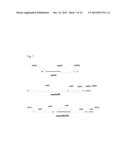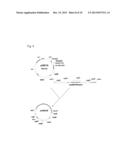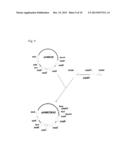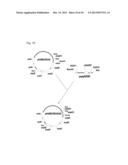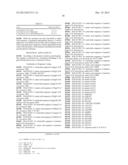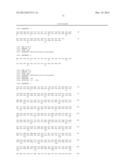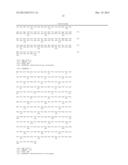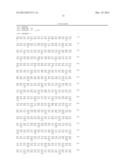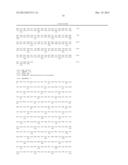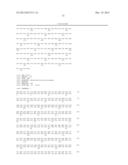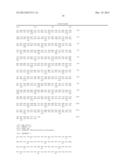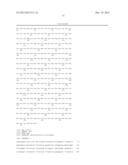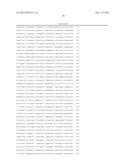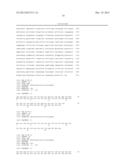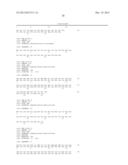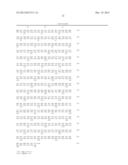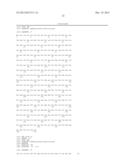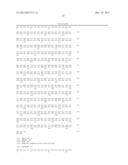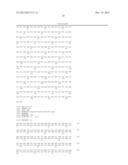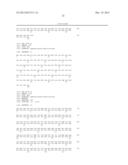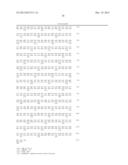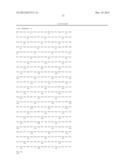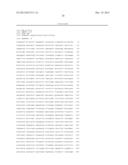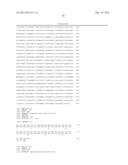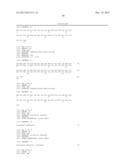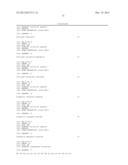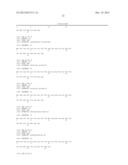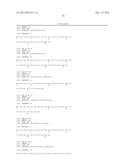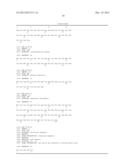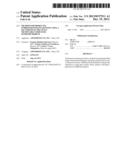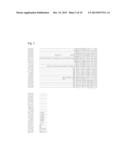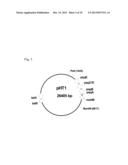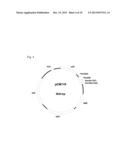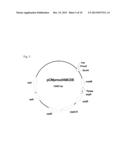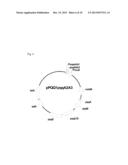Patent application title: Method for Producing Pyrroloquinoline Quinone Using a Bacterium of the Genus Methylobacterium or Hyphomicrobium
Inventors:
Evgeniy Rodionovich Gak (Moscow, RU)
Natalya Vasilievna Gorshkova (Moscow, RU)
Irina L'Vovna Tokmakova (Moscow Region, RU)
Assignees:
Ajinomoto Co., Inc.
IPC8 Class: AC12P1718FI
USPC Class:
435119
Class name: Preparing heterocyclic carbon compound having only o, n, s, se, or te as ring hetero atoms containing two or more hetero rings containing at least two hetero rings bridged or fused among themselves or bridged or fused with a common carbocyclic ring system, (e.g., rifamycin, etc.)
Publication date: 2013-12-19
Patent application number: 20130337511
Abstract:
The present invention provides a method for producing PQQ using a
bacterium belonging to the genera Methylobacterium or Hyphomicrobium,
which has been modified to enhance the expression of pqq gene cluster
and/or gene(s) encoding a precursor for PQQ biosynthesis.Claims:
1. A method for producing pyrroloquinoline quinone (PQQ) comprising: A)
cultivating in a culture medium a bacterium belonging to the genus
Hyphomicrobium, and B) collecting PQQ from the culture medium, wherein
the bacterium has been modified to enhance expression of pqq gene
cluster.
2. The method according to claim 1, wherein said pqq gene cluster is the pqqABC/DE operon from Methylobacterium extorquens.
3. The method according to claim 2, wherein said pqqABC/DE operon comprises DNA comprising the nucleotide sequences of SEQ ID NO: 1, SEQ ID NO: 3, SEQ ID NO: 5, and SEQ ID NO: 7, or variants thereof.
4. The method according to claim 1, wherein said pqq gene cluster is the pqqABCDE cluster from Hyphomicrobium denitrificans.
5. The method according to claim 4, wherein said pqqABCDE cluster comprises DNA comprising the nucleotide sequences of SEQ ID NO: 14, SEQ ID NO: 16, SEQ ID NO: 18, SEQ ID NO: 20, and SEQ ID NO: 22, or variants thereof.
6. The method according to claim 1, wherein the expression of said gene cluster is enhanced by increasing the copy number of said pqq gene cluster.
7. The method according to claim 6, wherein the increasing said copy number is achieved by introducing into the bacterium a vector comprising said gene cluster.
8. The method according to claim 1, wherein said bacterium is Hyphomicrobium denitrificans.
9. The method according to claim 1, wherein said culture medium comprises methanol as a carbon source.
10. A method for producing pyrroloquinoline quinone (PQQ) comprising: cultivating in a culture medium a bacterium belonging to the genus Methylobacterium or Hyphomicrobium, wherein said bacterium has enhanced expression of pqq gene cluster, and collecting PQQ from the culture medium, wherein said bacterium has been further modified to enhance expression of pqqA-like gene(s).
11. The method according to claim 10, wherein said pqq gene cluster is the pqqABC/DE operon from Methylobacterium extorquens.
12. The method according to claim 11, wherein said pqqABC/DE operon comprises DNA comprising the nucleotide sequences of SEQ ID NO: 1, SEQ ID NO: 3, SEQ ID NO: 5, and SEQ ID NO: 7, or variants thereof.
13. The method according to claim 6, wherein said pqq gene cluster is the pqqABCDE cluster from Hyphomicrobium denitrificans.
14. The method according to claim 10, wherein said pqqABCDE cluster comprises DNA comprising nucleotide sequences of SEQ ID NO: 14, SEQ ID NO: 16, SEQ ID NO: 18, SEQ ID NO: 20, and SEQ ID NO: 22, or variants thereof.
15. The method according to claim 11, wherein said pqqA-like gene is selected from the group consisting of: a DNA that encodes a protein comprising the amino acid sequence of SEQ ID No: 2; a DNA that encodes a protein comprising the amino acid sequence of SEQ ID NO: 2, but that contains substitutions, deletions, insertions, additions or inversions of one or several amino acid residues, and said protein has the function of PQQ precursor; a DNA that encodes a protein comprising the amino acid sequence of SEQ ID No: 11; a DNA that encodes a protein comprising the amino acid sequence of SEQ ID NO: 11, but that contains substitutions, deletions, insertions, additions or inversions of one or several amino acid residues, and said protein has the function of PQQ precursor; a DNA that encodes a protein comprising the amino acid sequence of SEQ ID No:13; a DNA that encodes a protein comprising the amino acid sequence of SEQ ID NO: 13, but that contains substitutions, deletions, insertions, additions or inversions of one or several amino acid residues, and said protein has the function of PQQ precursor; a DNA that encodes a protein comprising the amino acid sequence of SEQ ID No: 15; a DNA that encodes a protein comprising the amino acid sequence of SEQ ID NO: 15, but that contains substitutions, deletions, insertions, additions or inversions of one or several amino acid residues, and said protein has the function of PQQ precursor; a DNA that encodes a protein comprising the amino acid sequence of SEQ ID No: 26; a DNA that encodes a protein comprising the amino acid sequence SEQ ID NO: 26, but that contains substitutions, deletions, insertions, additions or inversions of one or several amino acid residues, and said protein has the function of PQQ precursor; a DNA that encodes a protein comprising the amino acid sequence of SEQ ID No: 28; a DNA that encodes a protein comprising the amino acid sequence of SEQ ID NO: 28, but that contains substitutions, deletions, insertions, additions or inversions of one or several amino acid residues, and said protein has the function of PQQ precursor, and combinations thereof.
16. The method according to claim 10, wherein the expression of said gene cluster or gene(s) is/are enhanced by increasing the copy number of said gene cluster or gene(s).
17. The method according to claim 16, wherein the increasing the copy number is achieved by introducing into the bacterium a vector comprising said gene cluster or gene(s).
18. The method according to claim 10, wherein said bacterium is Hyphomicrobium denitrificans.
19. The method according to claim 10, wherein said bacterium is Methylobacterium extorquens.
20. The method according to claim 10, wherein said culture medium comprises methanol as a carbon source.
Description:
[0001] This application is a Continuation of, and claims priority under 35
U.S.C. §120 to, International Application No. PCT/JP2012/055727,
filed Feb. 28, 2012, and claims priority therethrough under 35 U.S.C.
§119 to Russian Patent Application No. 2011108196, filed Mar. 3,
2011, the entireties of which are incorporated by reference herein. Also,
the Sequence Listing filed electronically herewith is hereby incorporated
by reference (File name: 2013-08-26_US-460 Seq List; File size: 68 KB;
Date recorded: Aug. 26, 2013).
BACKGROUND OF THE INVENTION
[0002] 1. Field of the Invention
[0003] The present invention relates to the microbiological industry, and specifically to a method for producing pyrroloquinoline quinine (PQQ) using a bacterium of the genus Methylobacterium or Hyphomicrobium which has been modified to enhance the expression of the pqq gene cluster and/or gene(s) encoding a precursor for PQQ biosynthesis.
[0004] 2. Brief Description of the Related Art
[0005] Pyrroloquinoline quinine (PQQ) is the cofactor for several bacterial dehydrogenases including glucose dehydrogenase and methanol dehydrogenase located in the periplasm of Gram-negative bacteria and may be accumulated extracellularly by cultivating these bacteria. All of the PQQ-producing strains have PQQ-dependent quinoproteins.
[0006] A method for the preparation of PQQ using bacteria belonging to the genera Achromobacter, Methylobacillus, Methylomonas, Methanomonas, Protaminobacter, Methylobacterium, Protomonas, Mycoplana, Ancyclobacter, Microcyclus, Hyphomicrobium, Xanthobacter, Thiobacillus, Alteromonas, Methylophaga and some species of the genus Pseudomonas, which are cultivated in a medium containing methanol and/or methylamine as a carbon source, is disclosed (EP0206471 B1).
[0007] Genes involved in PQQ biosynthesis have been characterized for several bacteria, including Klebsiella pneumoniae, Acinetobacter calcoaceticus, Methylobacterium extorquens, and Gluconobacter oxydans. Six genes and seven genes are required in K. pneumoniae and M. extorquens (AM1), respectively, and only four genes are required in A. calcoaceticus for PQQ biosynthesis. The pqqA genes from different species encode small peptides of 23 to 29 amino acids which contain conserved glutamic acid and tyrosine residues. PQQ is derived from the two amino acids glutammic acid and tyrosine encoded in the precursor peptide PqqA. Presumably, five reactions are necessary to form PQQ (Puehringer et al. BMC Biochemistry 2008, 9:8 doi:10.1186/1471-2091-9-8). Some of the proteins involved in PQQ biosynthesis have been functionally characterized.
[0008] The PqqB protein is supposed to be involved in transport of PQQ into the periplasm. It has been reported that a knock out of PqqB produces small amounts of PQQ in the cytosol and that no PQQ is secreted into the periplasm (Velterop et al. Journal of bacteriology (1995) 177(17):5088-5098). The PqqC protein is an oxidase which catalyzes the final step in PQQ formation. The functions of PqqD protein are still unknown. Recently, the interaction of PqqD protein with the radical SAM enzyme PqqE has been demonstrated in K. pneumoniae (Wecksler S R et al. Chem Commun 2010 Oct. 7; 46(37):7031-3).
[0009] Based on sequence analysis and homology models, it is supposed that PqqE recognizes the PqqA protein and forms a bond between the C atoms from the glutammic acid and tyrosine in PqqA, and, therefore, enables recognition of the modified PqqA by PqqF protein. In the next stage, PqqF is suggested to catalyze cutting of the generated glutammic acid-tyrosine pair out of PqqA protein (Puehringer et al. BMC Biochemistry 2008, 9:8 doi:10.1186/1471-2091-9-8).
[0010] It was revealed that PQQ biosynthesis in Escherichia coli, which does not possess an ability to produce PQQ, can be achieved through the expression of pqq gene clusters of A. calcoaceticus (Goosen N. et al. J Bacteriol (1989) 171:447-455), K. pneumoniae (Meulenberg J J M et al. FEMS Microbiol Lett (1990) 71:337-344), and G. oxydans (Yang et al. Journal of Industrial Microbiology&Biotechnology (2010), 37(6), 575-580). Also, the positive effect of copies of some pqq genes on PQQ production in Methylobacterium extorquens AM1 was described (Wu, Bo; Zhao, Yong-fang; Wang, Yin-shan.Wuhan Daxue Xuebao, Ziran Kexueban (1999) 45(6), 869-872). Deletion of mxbM gene and pqqABC/DE gene cluster in M. extorquens AM1 led to absence of PQQ production. The deletion mutant transformed by a plasmid harboring mxbM gene and pqqABC/DE gene cluster produced PQQ in larger amounts than the wild-type, presumably as a result of the higher copy number of pqq genes. (Toyama H. and Lidstorm M E. Microbiology (1998), 144, 183-191).
[0011] But, currently, there have been no reports of enhancing expression of the pqq gene cluster in a bacterium, belonging to the genus Hyphomicrobium, and enhancing expression of the additional pqqA gene(s) encoding a precursor for PQQ biosynthesis in a bacterium of the genera Methylobacterium or Hyphomicrobium for the purpose of producing PQQ.
SUMMARY OF THE INVENTION
[0012] Aspects of the present invention include providing methods for producing PQQ using a bacterium belonging to the genera Methylobacterium or Hyphomicrobium.
[0013] The above aspects were achieved by finding that enhancing expression of the pqq gene cluster and gene(s) encoding PqqA homologous proteins can enhance production of PQQ.
[0014] It is an aspect of the present invention to provide a method for producing PQQ comprising cultivating a bacterium belonging to the genus Hyphomicrobium, and collecting PQQ from the culture medium, wherein the bacterium has been modified to enhance expression of pqq gene cluster.
[0015] It is a further aspect of the present invention to provide the method as described above, wherein said pqq gene cluster is the pqqABC/DE operon from Methylobacterium extorquens.
[0016] It is a further aspect of the present invention to provide the method as described above, wherein said pqqABC/DE operon comprises DNA fragments of SEQ ID NO: 1, SEQ ID NO: 3, SEQ ID NO: 5, and SEQ ID NO: 7, or variants thereof.
[0017] It is a further aspect of the present invention to provide the method as described above, wherein said pqq gene cluster is the pqqABCDE cluster from Hyphomicrobium denitrificans.
[0018] It is a further aspect of the present invention to provide the method as described above, wherein said pqqABCDE cluster comprises DNA fragments of SEQ ID NO: 14, SEQ ID NO: 16, SEQ ID NO: 18, SEQ ID NO: 20, and SEQ ID NO: 22, or variants thereof.
[0019] It is a further aspect of the present invention to provide the method as described above, wherein the expression of said gene cluster is enhanced by increasing said gene cluster copy number.
[0020] It is a further aspect of the present invention to provide the method as described above, wherein the increasing said gene cluster copy number is achieved by introducing into the bacterium a vector containing said gene cluster.
[0021] It is a further aspect of the present invention to provide the method as described above, wherein said bacterium is Hyphomicrobium denitrificans.
[0022] It is a further aspect of the present invention to provide the method as described above, wherein said culture medium contains methanol as a carbon source.
[0023] It is an aspect of the present invention to provide a method for producing PQQ comprising cultivating a bacterium belonging to the genera Methylobacterium or Hyphomicrobium, having enhanced expression of pqq gene cluster, and collecting PQQ from the culture medium, wherein said bacterium has been further modified to enhance expression pqqA-like gene(s).
[0024] It is a further aspect of the present invention to provide the method as described above, wherein said pqq gene cluster is the pqqABC/DE operon from Methylobacterium extorquens.
[0025] It is a further aspect of the present invention to provide the method as described above, wherein said pqqABC/DE operon comprises DNA fragments of SEQ ID NO: 1, SEQ ID NO: 3, SEQ ID NO: 5, and SEQ ID NO: 7, or variants thereof.
[0026] It is a further aspect of the present invention to provide the method as described above, wherein said pqq gene cluster is the pqqABCDE cluster from Hyphomicrobium denitrificans.
[0027] It is a further aspect of the present invention to provide the method as described above, wherein said pqqABCDE cluster comprises DNA fragments of SEQ ID NO: 14, SEQ ID NO: 16, SEQ ID NO: 18, SEQ ID NO: 20, and SEQ ID NO: 22, or variants thereof.
[0028] It is a further aspect of the present invention to provide the method as described above, wherein said pqqA-like gene is selected from the group consisting of:
[0029] a DNA fragment that encodes a protein comprising the amino acid sequence of SEQ ID No: 2;
[0030] a DNA fragment that encodes a protein comprising the amino acid sequence SEQ ID NO: 2, but that contains substitutions, deletions, insertions, additions or inversions of one or several amino acid residues, and said protein has the function of a PQQ precursor;
[0031] a DNA fragment that encodes a protein comprising the amino acid sequence of SEQ ID No: 11;
[0032] a DNA fragment that encodes a protein comprising the amino acid sequence of SEQ ID NO: 11, but that contains substitutions, deletions, insertions, additions or inversions of one or several amino acid residues, and having the function of a PQQ precursor;
[0033] a DNA fragment that encodes a protein comprising the amino acid sequence of SEQ ID No:13;
[0034] a DNA fragment that encodes a protein comprising the amino acid sequence of SEQ ID NO: 13, but that contains substitutions, deletions, insertions, additions or inversions of one or several amino acid residues, and said protein has the function of a PQQ precursor;
[0035] a DNA fragment that encodes a protein comprising the amino acid sequence of SEQ ID No: 15;
[0036] a DNA fragment that encodes a protein comprising the amino acid sequence of SEQ ID NO: 15, but that contains substitutions, deletions, insertions, additions or inversions of one or several amino acid residues, and said protein has the function of a PQQ precursor;
[0037] a DNA fragment that encodes a protein comprising the amino acid sequence of SEQ ID No: 26;
[0038] a DNA fragment that encodes a protein comprising the amino acid sequence of SEQ ID NO: 26, but that contains substitutions, deletions, insertions, additions or inversions of one or several amino acid residues, and said protein has the function of a PQQ precursor;
[0039] a DNA fragment that encodes a protein comprising the amino acid sequence of SEQ ID No: 28;
[0040] a DNA fragment that encodes a protein comprising the amino acid sequence of SEQ ID NO: 28, but that contains substitutions, deletions, insertions, additions or inversions of one or several amino acid residues, and said protein has the function of a PQQ precursor; and
[0041] combinations thereof.
[0042] It is a further aspect of the present invention to provide the method as described above, wherein the expression of said gene cluster or gene(s) is/are enhanced by increasing said gene cluster or gene(s) copy number.
[0043] It is a further aspect of the present invention to provide the method as described above, wherein the increasing said gene cluster or gene(s) copy number is/are achieved by introducing into the bacterium a vector containing said gene cluster or gene(s) copy number.
[0044] It is a further aspect of the present invention to provide the method as described above, wherein said bacterium is Hyphomicrobium denitrificans.
[0045] It is a further aspect of the present invention to provide the method as described above, wherein said bacterium is Methylobacterium extorquens.
[0046] It is a further aspect of the present invention to provide the method as described above, wherein said culture medium comprises methanol as a carbon source.
BRIEF DESCRIPTION OF THE DRAWINGS
[0047] FIG. 1 shows PQQ biosynthesis gene clusters in various strains.
[0048] FIG. 2 shows an alignment of the PqqA homologous proteins from various microorganisms.
Q49148--encoded by pqqA gene from Methylobacterium extorquens AM1 (SEQ ID No: 2) C5AQY4--encoded by pqqA2 gene from Methylobacterium extorquens AM1 (SEQ ID No: 11) C5AQY5--encoded by pqqA3 gene from Methylobacterium extorquens AM1 (SEQ ID No: 13) C7C9M1--encoded by gene locus from Methylobacterium extorquens DM4 (SEQ ID No: 2) C7CLK2--encoded by gene locus from Methylobacterium extorquens DM4 (SEQ ID No: 11) D8JXU1--encoded by pqqA gene from Hyphomicrobium denitrificans ATCC51888 (SEQ ID No: 15) D8JSB5--encoded by pqqA2 gene from Hyphomicrobium denitrificans ATCC51888 (SEQ ID No: 26) D8JQF5--encoded by pqqA3 gene from Hyphomicrobium denitrificans ATCC51888 (SEQ ID No: 28) Q4KEK3--encoded by gene locus PFL--2223 (NCBI Entrez Gene) from Pseudomonas fluorescens Pf-5 (strain: Pf-5) (SEQ ID No: 37) Q4K4V2--encoded by gene locus PFL--5673 (NCBI Entrez Gene) from Pseudomonas fluorescens Pf-5 (strain: Pf-5) (SEQ ID No: 38) B2UEV0--encoded by gene locus Rpic--0286 (NCBI Entrez Gene) from Ralstonia pickettii 12J (SEQ ID No: 39) B2U914--encoded by gene locus Rpic--2488 (NCBI Entrez Gene) from Ralstonia pickettii 12J (SEQ ID No: 40) C6WTX0--encoded by gene loci Mmol--0459, Mmol--0021, Mmol--0993, or Mmol--0794 (NCBI Entrez Gene) from Methylotenera mobilis JLW8 (SEQ ID No: 41) A4YZY3--encoded by gene locus BRAD05793 (NCBI Entrez Gene) from Bradyrhizobium sp. ORS278 (SEQ ID No: 42) A4YZ28--encoded by gene locus BRAD05478 (NCBI Entrez Gene) from Bradyrhizobium sp. ORS278 (SEQ ID No: 43) A4YNW1--encoded by gene locus BRADO1710 (NCBI Entrez Gene) from Bradyrhizobium sp. ORS278 (SEQ ID No: 44) Q608P4--encoded by gene locus MCA1445.1 (NCBI Entrez Gene) from Methylococcus capsulatus Bath (SEQ ID No: 45) Q488A4--encoded by gene locus CPS--0862 (NCBI Entrez Gene) from Colwellia psychrerythraea 34H (SEQ ID No: 46) Q9L3B4--encoded by gene locus GOX0987 (NCBI Entrez Gene) from Gluconobacter oxydans 621H (SEQ ID No: 47) Q1GX88--encoded by gene locus Mfla--0021 (NCBI Entrez Gene) from Methylobacillus flagellatus KT (SEQ ID No: 48) A8LN54--encoded by gene locus Dshi--0450 (NCBI Entrez Gene) from Dinoroseobacter shibae DFL 12 (SEQ ID No: 49) B1LV85--encoded by gene locus Mrad2831--0519 (NCBI Entrez Gene) from Methylobacterium radiotolerans JCM 2831 (SEQ ID No:2) D41FL0--encoded by gene locus EAM--0512A(NCBI Entrez Gene) from Erwinia amylovora ATCC 49946 (SEQ ID No: 50) D7DHP0--encoded by gene loci M301--0054, M301--2651, M301--1191, or M301--2123 (NCBI Entrez Gene) from Methylotenera sp. 301 (SEQ ID No: 41) B1Y7S1--encoded by gene locus Lcho--0244 (NCBI Entrez Gene) from Leptothrix cholodnii (strain ATCC 51168, LMG 8142, SP-6) (Leptothrix discophora SP-6 (SEQ ID NO: 51)
[0049] FIG. 3 shows a map of plasmid pHT1.
[0050] FIG. 4 shows a map of plasmid pCM110.
[0051] FIG. 5 shows a map of plasmid pPQQ1 (pCMp.sub.maxafABCDE).
[0052] FIG. 6 shows a map of plasmid pPQQ1pqqA2A3.
[0053] FIG. 7 shows genetic organization of the pqq genes on the H. denitrificans chromosome. The positions of the primers used for PCR-amplification are shown by the arrows.
[0054] FIG. 8 shows construction of plasmid pHABCDE.
[0055] FIG. 9 shows construction of plasmid pHABCDEA3.
[0056] FIG. 10 shows construction of plasmid pHABCDEA3A2.
DESCRIPTION OF THE PREFERRED EMBODIMENTS
[0057] The present invention is described in detail below.
[0058] 1. Bacterium
[0059] The bacterium according to the presently disclosed subject matter can be a PQQ-producing bacterium, wherein the bacterium has been modified to have enhanced expression of the genes involved in the pyrroloquinoline quinone biosynthesis.
[0060] The term "PQQ-producing bacterium" can mean a bacterium which has an ability to produce and excrete a PQQ into a medium, when the bacterium is cultured in the medium. The term "PQQ-producing bacterium" also can mean a bacterium which is able to produce and cause accumulation of PQQ in a culture medium in an amount larger than a wild-type or parental strain, for example, Methylobacterium, such as the M. extorquens strain AM1, or Hyphomicrobium, such as the H. denitrificans strain ATCC51888. The term "PQQ-producing bacterium" can also mean that the microorganism is able to cause accumulation in a medium of an amount not less than 0.3 mg/L, and in another example, not less than 1.0 mg/L, of PQQ.
[0061] The phrase "a bacterium belonging to the genus Methylobacterium" can mean that the bacterium is classified as the genus Methylobacterium according to the classification known to a person skilled in the art of microbiology. Specifically, those classified into the group Methylobacterium according to the taxonomy used by the NCBI (National Center for Biotechnology Information) database (http://www.ncbi.nlm.nih.gov/Taxonomy/Browser/wwwtax.cgi) can be used. Examples of the bacterium belonging to the genus Methylobacterium include, but are not limited to, Methylobacterium extorquens (M. extorquens), Methylobacterium chloromethanicum, Methylobacterium mesophilicum, Methylobacterium nodulans, Methylobacterium organophilum, Methylobacterium oryzae, Methylobacterium podarium, Methylobacterium populi, Methylobacterium radiotolerans, Methylobacterium rhodesianum, Methylobacterium variabile, Methylobacterium sp., etc. According to the present taxonomy of the genus, Protomonas is reclassified into the genus Methylobacterium (Bousfield U and Green P N. Int J Syst Bacteriol 35 (1985), 209). The species Pseudomonas rhodos, Pseudomonas radiora, and Pseudomonas mesophilica, were also transferred to the genus Methylobacterium (Green P N and Bousfield U. Int J Syst Bacteriol 33 (1983), 875-877).
[0062] The phrase "bacterium belonging to the genus Hyphomicrobium" can mean that the bacterium is classified into the genus Hyphomicrobium according to the classification known to a person skilled in the art of microbiology, although the bacterium is not particularly limited. Specifically, those classified into the group Hyphomicrobium according to the taxonomy used by the NCBI (National Center for Biotechnology Information) database (http://www.ncbi.nlm.nih.gov/Taxonomy/Browser/wwwtax.cgi) can be used. Examples of the bacterium belonging to the genus Hyphomicrobium include, but are not limited to, Hyphomicrobium denitrificans (H. denitrificans), Hyphomicrobium aestuarii, Hyphomicrobium chloromethanicum, Hyphomicrobium denitrificans, Hyphomicrobium facile, Hyphomicrobium methylovorum, Hyphomicrobium vulgare, Hyphomicrobium sp., etc.
[0063] Examples of PQQ-producing bacteria and parent strains which can be used to derive PQQ-producing bacteria include, but are not limited to, bacterial strains which inherently have the ability to produce PQQ. For example, parent strains which can be used to derive PQQ-producing bacteria can include, but are not limited to, strains belonging to the genus Methylobacterium, such as M. mesophilicum ATCC 29983, a pink-pigmented bacterium that utilizes L(-)-arabinose, D(-)-galalctose, D(-)-glucose, glycerol, sodium citrate, sodium glutamate, sodium malate, sodium malonate, sodium pyruvate, and sodium succinate as sole carbon sources for energy (Austin and Goodfellow. Int. J. Syst. Bacteriol. 29: 373-378, 1979), M. extorquens AM1 (ATCC 43645, DSM 1337, JCM 2802, ATCC 14718, DSM 1338, JCM 2805) (Urakami and Komagata. (1984) Int. J. Syst. Bacteriol. 34 (2): 188-201); M. rhodesianum JCM 2808 (ATCC 21612), and M. rhodesianum JCM 2809 (ATCC 21613) (Green, Bousfield, Hood. Int. J. Syst. Bacteriol 0.38, 124-127, 1988). Examples of parent strains belonging to the genus Hyphomicrobium can include the strains H. variable NCIB 10517 (US3989594 (A)); H. vulgare NCIB 9698 (Skerman et al. Int. J. Syst. Bacteriol. 30: 225-420, 1980), H. methylovorum IFO 14180 (ATCC 35216) (Izumi et al. J. Ferment. Technol. 60, 371-375, 1982); and Hyphomicrobium sp. DSM 1869 (ATCC 51888) that utilizes methanol, monomethylamine, dimethylamine, trimethylamine, pectin, acetate as sole carbon sources, and possess the possibility to utilize formate and ethanol (Urakami et al. Int. J. Syst. Bacteriol., 1995, 45, 528-532).
[0064] Above-mentioned strains are available from ATCC (American Type Culture Collection, 12301 Parklawn Drive, Rockville, Md. 20852, P.O. Box 1549, Manassas, Va. 20108, United States of America), DSMZ (German Collection of Microorganisms and Cell Cultures, Inhoffenstrase 7B, 38124, Braunschweig, Germany), JCM (Japan Collection of Microorganisms (RIKEN BioResource Center, 2-1 Hirosawa, Wako, Saitama 351-0198, Japan), or NCIMB (National Collections of Industrial and Marine Bacteria, Tony Research Station 135, Abbey Road, Aberdeen AB9 8DG, United Kingdom).
[0065] The phrase "enhancing the expression of the gene cluster and/or gene(s)" can mean that the expression of the gene cluster and/or gene(s) is higher than that of a non-modified strain, for example, a wild-type strain. Examples of such modifications can include increasing the copy number of the expressed gene cluster or gene per cell, increasing the expression level of the gene cluster or gene, and so forth. The copy number of an expressed gene cluster or gene is measured, for example, by restricting the chromosomal DNA followed by Southern blotting using a probe based on the gene sequence, fluorescence in situ hybridization (FISH), and the like. The level of gene cluster or gene expression can be measured by various known methods including Northern blotting, quantitative RT-PCR, and the like. Furthermore, wild-type non-modified strains can include, for example, M. extorquens AM1, or H. denitrificans ATCC51888.
[0066] The term "pqq gene cluster" can mean a gene cluster or operon that encodes proteins involved in the PQQ biosynthesis. At present, for example, the sequences of the pqqADCDEF operon from Klebsiella pneumoniae, the pqqADCDE cluster from Acinetobacter calcoaceticus, the pqqADC/DE and pqqFG cluster from Methylobacterium extorquens, and the pqqADCDEF cluster from Gluconobacter oxydans have been disclosed. The schematic structures of pqq gene clusters from various microorganisms are shown in FIG. 1.
[0067] The genes encoding enzymes involving in PQQ biosynthesis in M. extorquens are known. M. extorquens contains a pqqABC/DE operon in which the pqqC and pqqD genes are fused, while the pqqFG genes form an operon with three other genes (Zhang et al. Microbiology 149:1033-1040 (2003)). The major pqqABC/DE operon is expressed under the control of one promoter located upstream of pqqA gene.
[0068] The term "pqqABC/DE operon from Methylobacterium extorquens" can mean a DNA that has a nucleotide sequence which includes the following structural genes: pqqA, pqqB, pqqCD, and pqqE genes, which encode a precursor and enzymes for PQQ biosynthesis.
[0069] The pqqA gene encodes a precursor for PQQ biosynthesis PqqA protein. The pqqA gene (nucleotides complementary to nucleotides in positions from 1825146 to 1825235; GenBank accession no. NC--012808.1; gi: 240136783) is located between the mxbM gene and the pqqB gene on the chromosome of M. extorquens strain AM1. The nucleotide sequence of the pqqA gene of the strain AM1 and the amino acid sequence of the PqqA protein encoded by the pqqA gene are shown in SEQ ID NO: 1 and SEQ ID NO: 2, respectively.
[0070] The pqqB gene encodes a PQQ synthesis protein PqqB with an unknown function. The pqqB gene (nucleotides complementary to nucleotides in positions from 1824199 to 1824891: GenBank accession no. NC--012808.1; gi: 240136783), is located between the pqqA gene and the pqqCD gene on the chromosome of M. extorquens strain AM1. The nucleotide sequence of the pqqB gene of the strain AM 1 and the amino acid sequence of the PqqB protein encoded by the pqqB gene are shown in SEQ ID NO: 3 and SEQ ID NO: 4, respectively.
[0071] The pqqCD gene encodes PQQ synthesis protein PqqCD. The pqqCD gene (nucleotides complementary to nucleotides in positions from 1822914 to 1824032: GenBank accession no. NC--012808.1; gi: 240136783) is located between the pqqB gene and the pqqE gene on the chromosome of M. extorquens strain AM1. The nucleotide sequence of the pqqCD gene of the strain AM1 and the amino acid sequence of the fused PqqCD protein encoded by the pqqCD gene are shown in SEQ ID NO: 5 and SEQ ID NO: 6, respectively.
[0072] The pqqE encodes PQQ synthesis protein PqqE with an unknown function. The pqqE gene (nucleotides complementary to nucleotides in positions from 1821763 to 1822887: GenBank accession no. NC--012808.1; gi: 240136783) is located between the pqqCD gene and the pqqE gene on the chromosome of the M. extorquens strain AM1. The nucleotide sequence of the pqqE gene of the strain AM1 and the amino acid sequence of the PqqE protein encoded by the pqqE gene are shown in SEQ ID NO: 7 and SEQ ID NO: 8, respectively.
[0073] The nucleotide sequence of the pqqABC/DE operon from M. extorquens AM1 is shown in SEQ ID NO: 9.
[0074] The complete genome sequences of several methylotrophic bacteria have been published recently. Analysis of the available genomes revealed the presence of additional copies of pqqA outside of the pqqABCDE cluster. In M. extorquens AM1, second and third copies located in tandem and presumably expressed under the control of one promoter, have been annotated. According to the present invention, one of the pqqA gene copies which is located between the serS gene, oriented in the opposite direction to the pqqA gene copies, and the other pqqA gene copy on the chromosome of M. extorquens AM1 (nucleotides in positions from 4753498 to 4753587: GenBank accession no. NC--012808.1; gi: 240136783), was given the name pqqA2 gene. The nucleotide sequence of the pqqA2 gene of the strain AM1 and the amino acid sequence of the PQQA2 protein encoded by the pqqA2 gene are shown in SEQ ID NO: 10 and SEQ ID NO: 11, respectively. Further according to the present invention, the other pqqA gene copy which is located between the pqqA2 gene and the MexAM1--META1p4630 gene, oriented in the opposite direction, on the chromosome of M. extorquens AM1 (nucleotides in positions from 4753650 to 4753739: GenBank accession no. NC--012808.1; gi: 240136783), was given the name pqqA3 gene. The nucleotide sequence of the pqqA3 gene of the strain AM1 and the amino acid sequence of the PQQA3 protein encoded by the pqqA3 gene are shown in SEQ ID NO: 12 and SEQ ID NO: 13, respectively.
[0075] The homology level between the PqqA, PqqA2 and PqqA3 proteins from M. extorquens AM1 is very high (see FIG. 2). Furthermore, inventors of the presently disclosed subject matter have examined available genome sequences of five strains of genera Methylobacterium and found that M. chloromethanicum CM4, M. populi BJ001, M. radiotolerans JCM2831 have the same organization of pqqA locus as M. extorquens AM1. M. extorquens DM4 has one additional copy of the pqqA gene located beyond the pqqABC/DE operon. Methylobacterium sp. 4-46 and M. nodulans ORS2060 have two copies of the pqqA gene located in the beginning of pqqABCDE cluster.
[0076] Computer analysis of the Hyphomicrobium denitrificans ATCC51888 genome revealed the presence of three gene copies of the pqqA gene which are located in different loci: the first pqqA gene copy (ORF Hden--1488), named according to the present invention the pqqA gene, is contained in a predicted pqqABCDE gene cluster, the second one (ORF Hden--0553), named according to the present invention the pqqA2 gene, is contained in a predicted pqqADE gene cluster, and the third one (ORF Hden--1488), named according to the present invention the pqqA3 gene, is located separately (see FIG. 7).
[0077] The term "pqqABCDE gene cluster from Hyphomicrobium denitrificans" can mean a nucleotide sequence which includes the following ORFs (ORF--open reading frame) encoding a precursor and putative PQQ biosynthesis enzymes: putative pqqA gene (Hden--1488), putative pqqB gene (Hden--1487), putative pqqC gene (Hden--1486), putative pqqD gene (Hden--1485), and putative pqqE gene (Hden--1484). The nucleotide sequence of the pqqA gene of H. denitrificans and the amino acid sequence of the putative PqqA protein encoded by the pqqA gene are shown in SEQ ID NO: 14 and SEQ ID NO: 15, respectively. The nucleotide sequence of the pqqB gene of H. denitrificans and the amino acid sequence of the putative PqqB protein encoded by the pqqB gene are shown in SEQ ID NO: 16 and SEQ ID NO: 17, respectively. The nucleotide sequence of the pqqC gene of H. denitrificans and the amino acid sequence of the putative PqqC protein encoded by the pqqC gene are shown in SEQ ID NO: 18 and SEQ ID NO: 19, respectively. The nucleotide sequence of the pqqD gene of H. denitrificans and the amino acid sequence of the putative PqqD protein encoded by the pqqD gene are shown in SEQ ID NO: 20 and SEQ ID NO: 21, respectively. The nucleotide sequence of the pqqE gene of H. denitrificans and the amino acid sequence of the putative PqqE protein encoded by the pqqE gene are shown in SEQ ID NO: 22 and SEQ ID NO: 23, respectively.
[0078] The nucleotide sequence of the pqqABCDE gene cluster from H. denitrificans ATCC51888 is shown in SEQ ID NO: 24.
[0079] The pqqA2 gene (synonym: Hden--0553) encodes a predicted PqqA protein. The pqqA2 gene (nucleotides complementary to nucleotides in positions from 585973 to 586080; GenBank accession no. NC--014313.1; gi: 300021538) is located between the Hden--0552 gene and the Hden--0554 gene on the chromosome of the H. denitrificans strain ATCC51888. The nucleotide sequence of the pqqA2 gene of the strain ATCC51888 and the amino acid sequence of the putative PqqA2 protein encoded by the pqqA2 gene are shown in SEQ ID NO: 25 and SEQ ID NO: 26, respectively.
[0080] The pqqA3 gene (synonym: Hden--2110) encodes a predicted PqqA protein. The pqqA3 gene (nucleotides complementary to nucleotides in positions from 2160533 to 2160432; GenBank accession no. NC--014313.1; gi: 300021538) is located between the Hden--2109 gene and the Hden--2111 gene, both oriented in opposite directions, on the chromosome of H. denitrificans strain ATCC51888. The nucleotide sequence of the pqqA3 gene of the strain ATCC51888 and the amino acid sequence of the putative PqqA3 protein encoded by the pqqA3 gene are shown in SEQ ID NO: 27 and SEQ ID NO: 28, respectively.
[0081] The term "pqqA-like gene" can mean a gene that is located in a bacterial genome and encodes a precursor for PQQ biosynthesis. According to the present invention, each of the above-described pqqA, pqqA2, and pqqA3 genes from M. extorquens AM1, also as pqqA, pqqA2, and pqqA3 genes from H. denitrificans ATCC51888, can be named "pqqA-like gene". The presence of a pqqA-like gene in a bacterial genome can be determined by analysis of the genome sequence, in addition to databases containing information about annotated pqqA genes from various microorganisms. pqqA-like genes from a wide range of microorganisms can be used. Examples of the bacterium containing in-genome pqqA-like gene are not limited to the above-mentioned methylotrophs. Examples of the bacterium containing in-genome pqqA-like genes can also include, Methylococcus capsulatus Bath, Colwellia psychrerythraea 34H, Gluconobacter oxydans 621H, Methylobacillus flagellatus KT, Dinoroseobacter shibae DFL 12, Leptothrix cholodnii SP-6, Erwinia amylovora ATCC 49946, Acinetobacter sp. RUH2624, Saccharopolyspora erythraea NRRL23338, Bradyrhizobium sp. ORS278, Bradyrhizobium sp. BTAi1/ATCC BAA-1182, Ralstonia pickettii 12J, Pseudomonas fluorescensa, etc. Some of the bacteria have multiple copies of pqqA-like gene in-genome, for instance, Methylotenera mobilis JLW8, Methylovorus sp. SIP3-4, Methylobacterium extorquens DM4, and Methylobacterium sp. 4-46.
[0082] Since there may be some differences in DNA sequences between the genera, species or strains, the gene cluster and the gene(s) which expression is/are enhanced are not limited to the genes shown in SEQ ID No: 1, SEQ ID No: 3, SEQ ID No: 5, SEQ ID No: 7, SEQ ID No: 10, SEQ ID No: 12, SEQ ID No: 14, SEQ ID No: 16, SEQ ID No: 18, SEQ ID No: 20, SEQ ID No: 22, SEQ ID No: 25, SEQ ID No: 27, but can include genes homologous to SEQ ID No: 1, SEQ ID No: 3, SEQ ID No: 5, SEQ ID No: 7, SEQ ID No: 10, SEQ ID No: 12, SEQ ID No: 14, SEQ ID No: 16, SEQ ID No: 18, SEQ ID No: 20, SEQ ID No: 22, SEQ ID No: 25, SEQ ID No: 27. Therefore, the protein variants encoded by the genes can have exemplary homology of not less than 80%, not less than 90%, or not less than 95%, with respect to the entire amino acid sequence shown in SEQ ID No: 1, SEQ ID No: 3, SEQ ID No: 5, SEQ ID No: 7, SEQ ID No: 10, SEQ ID No: 12, SEQ ID No: 14, SEQ ID No: 16, SEQ ID No: 18, SEQ ID No: 20, SEQ ID No: 22, SEQ ID No: 25, SEQ ID No: 27, as long as the activity or function of the corresponding protein is maintained. The term "homology" may also be used to refer to "identity". The phrase "protein variant", as used in the presently disclosed subject matter, means proteins which have changes in the sequences, whether they are deletions, insertions, additions, or substitutions of amino acids. The number of changes in the variant proteins can depend on the position in the three dimensional structure of the proteins or the type of amino acid residues. Exemplary embodiments can be 1 to 30, 1 to 15, 1 to 5, or 1 to 3 in SEQ ID NO:2, SEQ ID NO:4, SEQ ID NO:6, SEQ ID NO:8, SEQ ID NO:11, SEQ ID NO:13, SEQ ID NO:15, SEQ ID NO:17, SEQ ID NO:19, SEQ ID NO:21, SEQ ID NO:23, SEQ ID NO:26, or SEQ ID NO:28. These changes in the variants can occur in regions of the protein which are not critical for the three dimensional structure of the protein. This is because some amino acids have high homology to one another so the three dimensional structure is not affected by such a change. An alignment of the PqqA homologues proteins from different microorganisms is shown on FIG. 2. It is known that PqqA peptides from various microorganisms include two conserved glutamate and tyrosine residues, which are separated by three amino acid residues (sequence motif -E-X-X-X-Y, SEQ ID NO: 52). Changes in the protein variants can occur in non-conservative regions.
[0083] The term "a protein having the function of PQQ precursor" can mean that the protein can be involved in PQQ biosynthesis as a precursor for PQQ, specifically, the protein can have a three dimensional structure which is sufficient to be recognized and used as a substrate by PQQ biosynthesis enzymes with subsequent conversion into PQQ.
[0084] Homology between two amino acid sequences can be determined using the well-known methods, for example, the computer program BLAST 2.0, which calculates three parameters: score, identity and similarity.
[0085] The substitution, deletion, insertion or addition of one or several amino acid residues should be conservative mutation(s) so that the activity or the function is maintained. The representative conservative mutation is a conservative substitution. Examples of conservative substitutions can include substitution of Ser or Thr for Ala, substitution of Gln, H is or Lys for Arg, substitution of Glu, Gln, Lys, H is or Asp for Asn, substitution of Asn, Glu or Gln for Asp, substitution of Ser or Ala for Cys, substitution of Asn, Glu, Lys, His, Asp or Arg for Gln, substitution of Asn, Gln, Lys or Asp for Glu, substitution of Pro for Gly, substitution of Asn, Lys, Gln, Arg or Tyr for His, substitution of Leu, Met, Val or Phe for Be, substitution of Ile, Met, Val or Phe for Leu, substitution of Asn, Glu, Gln, His or Arg for Lys, substitution of Ile, Leu, Val or Phe for Met, substitution of Trp, Tyr, Met, Ile or Leu for Phe, substitution of Thr or Ala for Ser, substitution of Ser or Ala for Thr, substitution of Phe or Tyr for Trp, substitution of His, Phe or Trp for Tyr, and substitution of Met, Be or Leu for Val.
[0086] Therefore, the gene cluster and gene(s) can be a variant(s) which hybridizes under stringent conditions with the nucleotide sequence shown in SEQ ID No: 1, SEQ ID No: 3, SEQ ID No: 5, SEQ ID No: 7, SEQ ID No: 10, SEQ ID No: 12, SEQ ID No: 14, SEQ ID No: 16, SEQ ID No: 18, SEQ ID No: 20, SEQ ID No: 22, SEQ ID No: 25, SEQ ID No: 27, or a probe which can be prepared from the nucleotide sequence, provided that it encodes a functional protein. "Stringent conditions" can include those under which a specific hybrid, for example, a hybrid having homology of not less than 60%, is formed and a non-specific hybrid, for example, a hybrid having homology lower than the above, is not formed. Other exemplary homologies can include not less than 70%, not less than 80%, not less than 90%, not less than 95%, and not less than 98%. For example, stringent conditions are exemplified by washing one time or more, such as two or three times, at a salt concentration of 1×SSC, 0.1% SDS. Another exemplary salt concentration can include 0.1×SSC, 0.1% SDS at 60° C. Duration of washing depends on the type of membrane used for blotting and, as a rule, should be what is recommended by the manufacturer. For example, the recommended duration of washing for the Hybond® N+ nylon membrane (Amersham) under stringent conditions is 15 minutes. By way of example, washing can be performed 2 to 3 times. The length of the probe can be suitably selected depending on the hybridization conditions, and can be 100 by to 1 kbp, for example. Moreover, codons in the gene sequences may be replaced with other equivalent codons which are easily used in the host into which the genes are introduced.
[0087] Methods which can be used to enhance gene cluster and/or gene(s) expression include increasing the gene cluster and/or the gene(s) copy number, and introducing a gene cluster and/or a gene into a vector that is able to increase the copy number of the gene cluster and/or the gene in a bacterium of the Methylobacterium or Hyphomicrobium genera. Examples of vectors include but are not limited to broad-host-range vectors such as pCM110, pRK310, pVK101, pBBR122, pBHR1, and the like.
[0088] Enhancement of the gene cluster and/or gene expression can also be achieved by introducing multiple copies of the gene cluster and/or the gene into a bacterial chromosome by, for example, homologous recombination, Mu integration, or the like. For example, one act of Mu integration allows for the introduction of up to 3 copies of the gene into a bacterial chromosome.
[0089] The copy number of gene cluster and/or gene can also be increased by introducing multiple copies of the gene into the chromosomal DNA of the bacterium. In order to introduce multiple copies of the gene cluster and/or the gene into the bacterial chromosome, homologous recombination can be carried out using a sequence with multiple copies of the sequence in the chromosomal DNA. Sequences with multiple copies in the chromosomal DNA include, but are not limited to, repetitive DNA, or inverted repeats present at the end of a transposable element. Also, it is possible to incorporate the gene cluster and/or the gene into a transposon, and allow it to be transferred to introduce multiple copies of the gene cluster and/or the gene into the chromosomal DNA.
[0090] Enhancing of the gene cluster and/or gene expression may also be achieved by placing the DNAs under the control of a potent promoter. For example, the lac promoter, the trp promoter, the trc promoter, the PR, or the PL promoters of lambda phage are all known to be potent promoters. Potent promoters providing a high level of gene expression in a bacterium belonging to the genus Hyphomicrobium or Methylobacterium can be used. Especially, methanol dehydrogenase promoter P.sub.mxaF is known as a strong methanol-inducible promoter in Methylobacterium. The use of a potent promoter can be combined with multiplication of gene copies.
[0091] Alternatively, the effect of a promoter can be enhanced by, for example, introducing a mutation into the promoter to increase the transcription level of the gene cluster and/or the gene located downstream of the promoter. Furthermore, it is known that substitution of several nucleotides in the spacer between ribosome binding site (RBS) and the start codon, especially the sequences immediately upstream of the start codon, profoundly affect the mRNA translatability. For example, a 20-fold range in the expression levels was found, depending on the nature of the three nucleotides preceding the start codon (Gold et al., Annu. Rev. Microbiol., 35, 365-403, 1981; Hui et al., EMBO J., 3, 623-629, 1984).
[0092] Moreover, it is also possible to introduce a nucleotide substitution into the promoter region of the gene cluster and/or the gene on the bacterial chromosome, which results in a stronger promoter function.
[0093] Methods for preparation of plasmid DNA, digestion, and ligation of DNA, transformation, selection of an oligonucleotide as a primer, and the like may be ordinary methods well-known to one skilled in the art. These methods are described, for instance, in Sambrook, J., Fritsch, E. F., and Maniatis, T., "Molecular Cloning: A Laboratory Manual, Second Edition", Cold Spring Harbor Laboratory Press (1989).
[0094] 2. Method
[0095] The method for producing PQQ can be a method which includes the steps of cultivating the bacterium according to the presently disclosed subject matter in a culture medium to cause accumulation of PQQ in the medium, and collecting PQQ from the medium.
[0096] The cultivation, collection, and purification of the PQQ from the medium and the like may be performed in a manner similar to conventional fermentation methods wherein PQQ is produced using a bacterium.
[0097] The medium which can be used in the culture can be either a synthetic or natural medium, so long as the medium includes a carbon source, a nitrogen source, minerals and, if necessary, appropriate amounts of nutrients which the bacterium may require for growth. The carbon source can include various carbohydrates such as glucose and sucrose, various organic acids, alcohol including methanol, ethanol and glycerol. Methanol is the most preferable. The nitrogen source can include various ammonium salts such as ammonia and ammonium sulphate, other nitrogen compounds such as amines, a natural nitrogen source such as peptone, soybean-hydrolysate, and digested fermentative microorganism. The sulfur source can include ammonium sulphate, magnesium sulphate, ferrous sulphate, manganese sulphate, and the like. Minerals can include potassium monophosphate, sodium chloride, calcium chloride, and the like. Vitamins can include thiamine, yeast extract, and the like.
[0098] The cultivation can be performed under aerobic conditions such as a shaking culture or a stirring culture with aeration, at a temperature of 20 to 40° C., and in another example 25 to 37° C. The pH of the culture is usually between 5 and 9, and in another example between 6 and 8. The pH of the culture can be adjusted with ammonia, calcium carbonate, various acids, various bases, and buffers. Usually, a 1 to 5-day cultivation period leads to the accumulation of PQQ in the liquid medium.
[0099] After cultivation, solids such as cells can be removed from the liquid medium by centrifugation or membrane filtration, and the PQQ can be collected and purified by ion-exchange, concentration, and crystallization methods.
EXAMPLES
[0100] The present invention will be more concretely explained below with reference to the following non-limiting examples.
Example 1
Construction of Plasmids Containing PQQ Biosynthesis Genes from M. extorquens
[0101] Construction of the Plasmid pPQQ1
[0102] The plasmid pPQQ1 was constructed for overexpression of pqqABC/DE operon from M. extorquens AM1 (FIG. 5). For this purpose, plasmid pHT1 (FIG. 3; Toyama H, Lidstrom M E. Microbiology. 1998 January; 144 (Pt 1):183-91)) was treated with restrictases BamHI and XhoI followed by treatment with a Klenow fragment of DNA-polymerase I. After that, the 6.2 kb blunted BamHI-XhoI fragment containing pqqABC/DE operon and gene mxbM encoding the positive regulator of the pqq genes from M. extorquens was cloned into the region between BamHI-Ec1136II sites of vector pCM110 (FIG. 4, the GenBank accession number for this cloning vector is AF327718) to produce plasmid pQQ1 (FIG. 5). The ligated mixture was transformed to E. coli TG1 strain (DSM 6056) and plasmid DNA was isolated from the clones grown on LB plates with tetracyclin (10 μg/ml). The plasmids of the expected structure were selected using restriction analysis. The resulting plasmid was given the name pQQ1. E. coli TG1 strain is available from DSMZ (German Collection of Microorganisms and Cell Cultures, Inhoffenstrase 7B, 38124, Braunschweig, Germany).
[0103] To check whether the mxbM gene overexpression had an affect on PQQ production, the second plasmid pPQQ2 without promoter P.sub.mxaF was constructed. Deletion of P.sub.mxaF was obtained as following: the plasmid pPQQ1 was digested with restrictases BamHI and PstI, blunt-ended, and then self-ligated. The resulting plasmid contained pqqABC/DE operon expressing under the control of the native promoter which is located on the plasmid downstream of the gene mxbM. The construction of strains M. extorquens/pPQQ1 and M. extorquens/pPQQ2, and assay of the amount of produced PQQ, were conducted as described in Example 3. The strains M. extorquens AM1/pPQQ1 and M. extorquens AM1/pPQQ2 showed a nearly identical amount of accumulated PQQ (see Table1). Thus, according to the obtained data, enhancing the mxbM gene expression does not significantly contribute to increasing PQQ production by the strain with enhanced expression of the pqq genes. Plasmid pPQQ1 was used for the further experiments.
TABLE-US-00001 TABLE 1 Strain PQQ, mg/l (HPLC) M. extorquens AM1/pPQQ1 52.5 ± 0.7 M. extorquens AM1/pPQQ2 53.5 ± 0.7
[0104] 2. Construction of the Plasmid pPQQ1pqqA2A3
[0105] The plasmid pPQQ1pqqA2A3 was constructed for overexpression of pqqABC/DE operon and two pqqA gene copies--the pqqA2 gene and the pqqA3 gene, from M. extorquens AM1. For this purpose, DNA fragment containing the pqqA2 and pqqA3 genes under transcriptional control of its own promoter was generated by PCR using primers EG539 (SEQ ID NO: 29) and EG540 (SEQ ID NO: 30). Chromosome DNA isolated from the M. extorquens AM1 was used as the template in the reaction. The temperature profile was the following: initial DNA denaturation for 5 min at 95° C., followed by 30 cycles of denaturation at 95° C. for 30 sec, annealing at 57° C. for 30 sec, elongation at 72° C. for 2 min, and the final elongation for 5 min at 72° C.
[0106] The obtained 1.1 kb fragment was purified followed by treatment with PstI restrictase, and cloned into SwaI-PstI sites of the pPQQ1 plasmid to produce pPQQ1pqqA2A3 (FIG. 6). The ligated mixture was transformed to E. coli TG1 strain and plasmid DNA was isolated from the clones grown on LB plates with tetracyclin (10 μg/ml). The plasmids of the expected structure have been selected using restriction analysis. The resulting plasmid was given the name pQQ1pqqA2A3.
Example 2
Construction of Plasmids Containing PQQ Biosynthesis Genes from Hyphomicrobium denitrificans
[0107] Construction of the plasmid pHABCDE.
[0108] The plasmid pHABCDE was constructed for overexpression of pqqABCDE gene cluster from H. denitrificans ATCC51888 (DSM1869) (the strain was obtained from German Collection of Microorganisms and Cell Cultures (DSMZ)). For this purpose, DNA fragment containing pqqABCDE gene cluster was generated by PCR using primers EG572 (SEQ ID NO: 35) and EG573 (SEQ ID NO: 36). Chromosome DNA isolated from the H. denitrificans ATCC51888 was used as the template in the reaction. The temperature profile was the following: initial DNA denaturation for 5 min at 95° C., followed by 30 cycles of denaturation at 95° C. for 30 sec, annealing at 57° C. for 30 sec, elongation at 72° C. for 2 min and the final elongation for 5 min at 72° C.
[0109] The obtained 3.7 kb fragment was purified followed by treatment with BamHI and SacI restrictases, and ligated into the pCM110 plasmid which had been previously treated with the same endonucleases, to produce pHABCDE (FIG. 8). The ligated mixture was transformed to E. coli TG1 strain and plasmid DNA was isolated from the clones grown on LB plates with tetracyclin (10 μg/ml). The plasmids of the expected structure have been selected using restriction analysis. The resulting plasmid was given the name pHABCDE.
[0110] 2. Construction of Plasmid pHABCDEA3.
[0111] The plasmid pHABCDEA3 was constructed for overexpression of pqqABCDE gene cluster and pqqA3 gene from H. denitrificans ATCC51888. For this purpose, DNA fragment containing pqqA3 gene was generated by PCR using primers EG568 (SEQ ID NO: 31) and EG569 (SEQ ID NO: 32). Chromosome DNA isolated from the H. denitrificans ATCC51888 was used as the template in the reaction. The temperature profile was the following: initial DNA denaturation for 5 min at 95° C., followed by 30 cycles of denaturation at 95° C. for 30 sec, annealing at 57° C. for 30 sec, elongation at 72° C. for 2 min and the final elongation for 5 min at 72° C.
[0112] The obtained 0.27 kb fragment was purified followed by treatment with XbaI restrictase, and cloned between the XbaI and SwaI sites of the plasmid pHABCDE to produce pHABCDEA3 (FIG. 9). The ligated mixture was transformed to E. coli TG1 strain and plasmid DNA was isolated from the clones grown on LB plates with tetracyclin (10 μg/ml). The plasmids of the expected structure have been selected using restriction analysis. The resulting plasmid was given the name pHABCDEA3.
[0113] 3. Construction of the Plasmid pHABCDEA2A3.
[0114] The plasmid pHABCDEA2A3 was constructed for overexpression of the pqqA3 and pqqA2 genes from H. denitrificans in addition to pqqABCDE gene cluster. For this purpose, a DNA fragment containing pqqA2 gene was generated by PCR using primers EG570 (SEQ ID NO: 33) and EG571 (SEQ ID NO: 34). Chromosome DNA isolated from the H. denitrificans ATCC51888 was used as the template in the reaction. The temperature profile was the following: initial DNA denaturation for 5 min at 95° C., followed by 30 cycles of denaturation at 95° C. for 30 sec, annealing at 57° C. for 30 sec, elongation at 72° C. for 2 min and the final elongation for 5 min at 72° C.
[0115] The obtained 0.36 kb fragment was purified followed by treatment with XbaI and BamHI restrictases, and cloned between the BamHI and XbaI sites of the plasmid pHABCDEA3 to produce pHABCDEA2A3 (FIG. 10). The ligated mixture was transformed to E. coli TG1 strain and plasmid DNA was isolated from the clones grown on LB plates with tetracyclin (10 μg/ml). The plasmids of the expected structure have been selected using restriction analysis. The resulting plasmid was given the name pHABCDEA2A3.
Example 3
Production of PQQ by M. extorquens Strains AM1/pPQQ1 and AM1/pPQQ1pqqA2A3
[0116] To test the effect of the enhanced expression of the pqqA2 and pqqA3 genes and pqqABC/DE operon from M. extorquens AM1 on PQQ production, plasmids pPQQ1 and pPQQ1pqqA2A3 were transferred in PQQ-producing strain M. extorquens AM1 by biparental mating using E. coli strain S17-1 (ATCC 47055), bearing the respective plasmids, as described by Abalakina et al. (Abalakina et al. Appl Microbiol Biotechnol.; 81(1):191-200 (2008)), with some modifications: Hypho medium (Harder, Attwood, and Quayle. J. Gen. Microbiol. 78 155-163 (1973)) with 1% of methanol and supplemented with 10 ml/l of vitamin stock solution of following composition: biotin 2.0 mg/l, folic acid 2.0 mg/l, thiamine-HCl 5.0 mg/l, Ca pantothenate 5.0 mg/l, B 12 0.1 mg/l, riboflavin 5.0 mg/l, nicotinamide 5.0 mg/l; was used for M. extorquens strains cultivation.
[0117] The obtained M. extorquens strains, AM1/PQQ1 and AM1/pPQQ1pqqA2A3, and control strain AM1, were separately cultivated for 60 hours on the plate of supplemented Hypho medium (as described above), one loop (from 1/8 plate) of the grown biomass were used as seed cultures, each of the cultures were inoculated into 5 ml of the supplemented Hypho medium, and were each cultivated at 30° C. for 72 hours with a rotary shaker at 240 rpm. For maintenance of the plasmid, 10 μg/ml of tetracycline was supplemented during the course of cultivation.
[0118] After the cultivation, the amount of PQQ which had accumulated in the medium was determined by HPLC analysis. The analytic conditions for HPLC were the following: column: Inertsil ODS-3(4 μm, 150 mm×4.6 mm I.D); eluents: (A) CH3OH, (B) 15 mM TBA solution, A/B=50/50 (V/V) gradient mixer; flow rate: 1.0 ml/min; column temperature: 40° C.; detection UV250 nm or FL Ex 360 nm Em 455 nm; injection vol.: 5 μl. TBA solution: Tetra-butylammonium (4.8 g) is solved in water (1 L) and pH is adjusted to 3.5 by phosphate. Additionally, an optical density of each culture at 600 nm (OD 600) was measured.
[0119] The results of the test tube fermentations are shown in Table 2 and in Table 3. As it can be seen from Table 2, M. extorquens strain AM1/pPQQ1 with enhanced expression of the pqqABC/DE operon from M. extorquens AM1 demonstrated an 8-fold higher amount of accumulation of PQQ as compared with the parent strain. As it can be seen from Table 3, strain AM1/pPQQ1pqqA2A3 with enhanced expression of the pqqA2 and pqqA3 genes in addition to the pqqABC/DE operon, demonstrated a doubled amount of accumulation of PQQ as compared with the strain M. extorquens AM1/pPQQ1.
TABLE-US-00002 TABLE 2 Strain OD600 nm PQQ, mg/l (HPLC) M. extorquens AM1 7.9 3.9 M. extorquens AM1/pPQQ1 8.6 ± 0.9 31.4 ± 1
TABLE-US-00003 TABLE 3 Strain OD600 nm PQQ, mg/l (HPLC) M. extorquens AM1/pPQQ1 10.7 50.0 M. extorquens AM1/pPQQ1pqqA2A3 11.5 ± 0.1 114.0 ± 2.8
Example 4
Production of PQQ by H. denitrificans Strains ATCC51888/pHABCDE, ATCC51888/pHABCDEA3, and ATCC51888/pHABCDEA2A3
[0120] To test the effect of the enhanced expression of the pqqA2 and pqqA3 genes and pqqABCDE gene cluster from H. denitrificans on PQQ production, plasmids pHABCDE, pHABCDEA3, and pHABCDEA2A3 were transferred into H. denitrificans strain ATCC51888 by biparental mating using E. coli strain S 17-1 bearing the respective plasmids as described by Abalakina et al. (Abalakina et al. Appl Microbiol Biotechnol.; 81(1):191-200 (2008)), with some modifications: B medium (Urakami et al. Applied And Environmental Microbiology, Vol. 58, No12, p. 3970-3976, 1992) with 1% of methanol was used for H. denitrificans strains cultivation.
[0121] The obtained H. denitrificans strains, ATCC51888/pHABCDE, ATCC51888/pHABCDEA3, ATCC51888/pHABCDEA2A3, and the control strain ATCC51888, were separately cultivated for 60 hours on the plate of B medium and one loop (from 1/8 plate) of biomass grown were used as seed cultures, each of the cultures were inoculated into 5 ml of the B medium, and were each cultivated at 30° C. for 72 hours with a rotary shaker at 240 rpm. For maintenance of the plasmid, 10 μg/ml of tetracycline was supplemented during the course of cultivation.
[0122] After the cultivation, the amount of PQQ which had accumulated in the medium was determined by HPLC analysis, as described above.
[0123] The results of the test tube fermentations are shown in Table 4. As it can be seen from Table 4, H. denitrificans strain ATCC51888/pHABCDE with enhanced expression of the pqqABCDE gene cluster from H. denitrificans demonstrated a higher amount of accumulation of PQQ as compared with the parent strain ATCC51888. The strain H. denitrificans ATCC51888/pHABCDEA3 with enhanced expression of the pqqA3 gene from H. denitrificans also demonstrated a higher amount of accumulation of PQQ as compared with the parent strain and the strain ATCC51888/pHABCDE. The strain ATCC51888/pHABCDEA2A3 with enhanced expression of the pqqA2 and pqqA3 genes in addition to pqqABCDE gene cluster demonstrated the highest amount of accumulation of PQQ.
TABLE-US-00004 TABLE 4 Strain PQQ, mg/l (HPLC) H. denitrificans ATCC51888 7.5 ± 0.1 H. denitrificans ATCC51888/pHABCDE 9.6 ± 0.1 H. denitrificans ATCC51888/pHABCDEA3 10.2 ± 0.1 H. denitrificans ATCC51888/pHABCDEA2A3 10.9 ± 0.1
Example 5
Production of PQQ by H. denitrificans Strains ATCC51888/pQQ1 and ATCC51888/PQQ1A2A3
[0124] To test the effect of the enhanced expression of the pqqA2 and pqqA3 genes, and pqqABC/DE operon from M. extorquens AM1, on PQQ production by H. denitrificans, plasmids pPQQ1 and pPQQ1pqqA2A3 were transferred into H. denitrificans strain ATCC51888 by biparental mating using E. coli strain S 17-1 bearing the respective plasmids as described by Abalakina et al. (Abalakina et al. Appl Microbiol Biotechnol.; 81(1):191-200 (2008)), with some modifications: B medium (Urakami et al. Applied And Environmental Microbiology, Vol. 58, No12, p. 3970-3976, 1992) with 1% of methanol was used for H. denitrificans strains cultivation.
[0125] Both H. denitrificans strains, ATCC51888/pQQ1 and ATCC51888/pQQ1A2A3, were separately cultivated for 60 hours on a plate of B medium, and one loop (from 1/8 plate) of biomass grown on each plate was used as a seed culture. Each of the cultures were inoculated into 5 ml of the B medium, and cultivated at 30° C. for 72 hours with a rotary shaker at 240 rpm. For maintenance of the plasmid, 10 μg/ml of tetracycline was supplemented during the course of cultivation.
[0126] After the cultivation, the amount of PQQ which had accumulated in the medium was determined by HPLC analysis, as described above.
[0127] The results of the test tube fermentations are shown in Table 5. As it can be seen from Table 5, H. denitrificans strain ATCC51888/pQQ1 with enhanced expression of the pqqABC/DE operon from M. extorquens AM1 demonstrated a higher amount of accumulation of PQQ as compared with the parent strain H. denitrificans ATCC51888. The strain H. denitrificans ATCC51888/pQQ1pqqA2pqqA3 with enhanced expression of the pqqA2 and pqqA3 genes from M. extorquens AM1 in addition to the pqqABC/DE operon demonstrated a higher amount of accumulation of PQQ as compared with the parent strain and the strain ATCC51888/pQQ1.
TABLE-US-00005 TABLE 5 Strain PQQ, mg/l (HPLC) H. denitrificans ATCC51888 7.5 ± 0.1 H. denitrificans ATCC51888/pPQQ1 8.3 ± 0.1 H. denitrificans ATCC51888/pPQQ1pqqA2A3 10.6 ± 0.1
[0128] While the invention has been described in detail with reference to preferred embodiments thereof, it will be apparent to one skilled in the art that various changes can be made, and equivalents employed, without departing from the scope of the invention. All documents cited herein are hereby incorporated by reference.
INDUSTRIAL APPLICABILITY
[0129] According to the present invention, pyrroloquinoline quinine is produced by a bacterium belonging to the genus Methylobacterium or Hyphomicrobium.
Explanation of Sequence Listing
[0130] SEQ ID NO: 1: nucleotide sequence of pqqA of M. extorquens AM1
[0131] SEQ ID NO: 2: amino acid sequence of PqqA of M. extorquens AM1, C7C9M1, B1LV85
[0132] SEQ ID NO: 3: nucleotide sequence of pqqB of M. extorquens AM1
[0133] SEQ ID NO: 4: amino acid sequence of PqqB of M. extorquens AM1
[0134] SEQ ID NO: 5: nucleotide sequence of pqqCD of M. extorquens AM1
[0135] SEQ ID NO: 6: amino acid sequence of PqqCD of M. extorquens AM1
[0136] SEQ ID NO: 7: nucleotide sequence of pqqE of M. extorquens AM1
[0137] SEQ ID NO: 8: amino acid sequence of PqqE of M. extorquens AM1
[0138] SEQ ID NO: 9: nucleotide sequence of pqqABC/DE operon of M. extorquens AM1
[0139] SEQ ID NO: 10: nucleotide sequence of pqqA2 of M. extorquens AM1
[0140] SEQ ID NO: 11: amino acid sequence of PQQA2 of M. extorquens AM1, C7CLK2
[0141] SEQ ID NO: 12: nucleotide sequence of pqqA3 of M. extorquens AM1
[0142] SEQ ID NO: 13: amino acid sequence of PQQA3 of M. extorquens AM1
[0143] SEQ ID NO: 14: nucleotide sequence of putative pqqA of H. denitrificans
[0144] SEQ ID NO: 15: amino acid sequence of putative PqqA of H. denitrificans
[0145] SEQ ID NO: 16: nucleotide sequence of putative pqqB of H. denitrificans
[0146] SEQ ID NO: 17: amino acid sequence of putative PqqB of H. denitrificans
[0147] SEQ ID NO: 18: nucleotide sequence of putative pqqC of H. denitrificans
[0148] SEQ ID NO: 19: amino acid sequence of putative PqqC of H. denitrificans
[0149] SEQ ID NO: 20: nucleotide sequence of putative pqqD of H. denitrificans
[0150] SEQ ID NO: 21: amino acid sequence of putative PqqD of H. denitrificans
[0151] SEQ ID NO: 22: nucleotide sequence of putative pqqE of H. denitrificans
[0152] SEQ ID NO: 23: amino acid sequence of putative PqqE of H. denitrificans
[0153] SEQ ID NO: 24: nucleotide sequence of pqqABCDE gene cluster of H. denitrificans ATCC51888
[0154] SEQ ID NO: 25: nucleotide sequence of putptive pqqA2 of H. denitrificans strain ATCC51888
[0155] SEQ ID NO: 26: amino acid sequence of putative PqqA2 of H. denitrificans strain ATCC51888
[0156] SEQ ID NO: 27: nucleotide sequence of putptive pqqA3 of H. denitrificans strain ATCC51888
[0157] SEQ ID NO: 28: amino acid sequence of putative PqqA3 of H. denitrificans strain ATCC51888
[0158] SEQ ID NO: 29: primer EG539
[0159] SEQ ID NO: 30: primer EG540
[0160] SEQ ID NO: 31: primer EG568
[0161] SEQ ID NO: 32: primer EG569
[0162] SEQ ID NO: 33: primer EG570
[0163] SEQ ID NO: 34: primer EG571
[0164] SEQ ID NO: 35: primer EG572
[0165] SEQ ID NO: 36: primer EG573
[0166] SEQ ID NO: 37: Q4KEK3
[0167] SEQ ID NO: 38: Q4K4V2
[0168] SEQ ID NO: 39: B2UEV0
[0169] SEQ ID NO: 40: B2U9I4
[0170] SEQ ID NO: 41: C6WTX0, D7DHP0
[0171] SEQ ID NO: 42: A4YZY3
[0172] SEQ ID NO: 43: A4YZ28
[0173] SEQ ID NO: 44: A4YNW1
[0174] SEQ ID NO: 45: Q608P4
[0175] SEQ ID NO: 46: Q488A4
[0176] SEQ ID NO: 47: Q9L3B4
[0177] SEQ ID NO: 48: Q1GX88
[0178] SEQ ID NO: 49: A8LN54
[0179] SEQ ID NO: 50: D41FL0
[0180] SEQ ID NO: 51: B1Y7S1
[0181] SEQ ID NO: 52: sequence motif -E-X-X-X-Y
Sequence CWU
1
1
52190DNAMethylobacterium extorquensCDS(1)..(90) 1atg aag tgg gct gcc ccc
atc gtt tcc gag atc tgc gtc ggc atg gaa 48Met Lys Trp Ala Ala Pro
Ile Val Ser Glu Ile Cys Val Gly Met Glu 1 5
10 15 gtc acg agc tac gag tcg gcc
gag atc gac acc ttc aac taa 90Val Thr Ser Tyr Glu Ser Ala
Glu Ile Asp Thr Phe Asn 20
25 229PRTMethylobacterium
extorquens 2Met Lys Trp Ala Ala Pro Ile Val Ser Glu Ile Cys Val Gly Met
Glu 1 5 10 15 Val
Thr Ser Tyr Glu Ser Ala Glu Ile Asp Thr Phe Asn 20
25 3693DNAMethylobacterium extorquensCDS(1)..(693)
3atg cat ccg cgc gag ggc ctg cgc cac tcg ccg atc cac gcg gtg ctg
48Met His Pro Arg Glu Gly Leu Arg His Ser Pro Ile His Ala Val Leu
1 5 10 15
ctg acg aac ggc gac gtc gat cac gtt gcg ggc ctg ctg acc ctg cgc
96Leu Thr Asn Gly Asp Val Asp His Val Ala Gly Leu Leu Thr Leu Arg
20 25 30
gag ggc cag ccc ttc acg ctc tac gcg aca ccc ggc atc ctg gcc tcc
144Glu Gly Gln Pro Phe Thr Leu Tyr Ala Thr Pro Gly Ile Leu Ala Ser
35 40 45
gtc tcc gac aac cgc gtc ttc gac gtg atg gcc gcc gac gtg gtg aag
192Val Ser Asp Asn Arg Val Phe Asp Val Met Ala Ala Asp Val Val Lys
50 55 60
cgg cag acg atc gcc ctc aac gag acc ttc gag ccg gtg ccc ggc ctc
240Arg Gln Thr Ile Ala Leu Asn Glu Thr Phe Glu Pro Val Pro Gly Leu
65 70 75 80
tcg gtg acg ctg ttc tcc gtc ccc ggc aag gtg ccg ctc tgg ctg gaa
288Ser Val Thr Leu Phe Ser Val Pro Gly Lys Val Pro Leu Trp Leu Glu
85 90 95
gac gcc tcg atg gag atc ggg gcg gag acc gaa acc acg gtc ggc acg
336Asp Ala Ser Met Glu Ile Gly Ala Glu Thr Glu Thr Thr Val Gly Thr
100 105 110
atg atc gag gcc ggg ggc aag cgc ctc gcc tac atc ccc ggc tgc gcc
384Met Ile Glu Ala Gly Gly Lys Arg Leu Ala Tyr Ile Pro Gly Cys Ala
115 120 125
cgg gtg acg gag gat ctc aaa gcc cgc atc gcc ggc gca gac gcg ctc
432Arg Val Thr Glu Asp Leu Lys Ala Arg Ile Ala Gly Ala Asp Ala Leu
130 135 140
ctg ttc gac ggc acg gtg ctg gag gac gac gac atg atc cgc gcc ggt
480Leu Phe Asp Gly Thr Val Leu Glu Asp Asp Asp Met Ile Arg Ala Gly
145 150 155 160
gtc ggc acc aag acc ggc tgg cgc atg ggc cat atc cag atg aac ggc
528Val Gly Thr Lys Thr Gly Trp Arg Met Gly His Ile Gln Met Asn Gly
165 170 175
gag acc ggc tcg atc gcg tct ctc gcc gat atc gag atc ggc cga cgg
576Glu Thr Gly Ser Ile Ala Ser Leu Ala Asp Ile Glu Ile Gly Arg Arg
180 185 190
gtc ttc gtt cac atc aac aac acc aat ccg gtc ctg atc gag gat tcg
624Val Phe Val His Ile Asn Asn Thr Asn Pro Val Leu Ile Glu Asp Ser
195 200 205
tac gag cgc gcg agc gtc gag gcg cgc ggc tgg acc gtc gcc cat gac
672Tyr Glu Arg Ala Ser Val Glu Ala Arg Gly Trp Thr Val Ala His Asp
210 215 220
ggc ctg acc ctc gat ctc tga
693Gly Leu Thr Leu Asp Leu
225 230
4230PRTMethylobacterium extorquens 4Met His Pro Arg Glu Gly Leu Arg His
Ser Pro Ile His Ala Val Leu 1 5 10
15 Leu Thr Asn Gly Asp Val Asp His Val Ala Gly Leu Leu Thr
Leu Arg 20 25 30
Glu Gly Gln Pro Phe Thr Leu Tyr Ala Thr Pro Gly Ile Leu Ala Ser
35 40 45 Val Ser Asp Asn
Arg Val Phe Asp Val Met Ala Ala Asp Val Val Lys 50
55 60 Arg Gln Thr Ile Ala Leu Asn Glu
Thr Phe Glu Pro Val Pro Gly Leu 65 70
75 80 Ser Val Thr Leu Phe Ser Val Pro Gly Lys Val Pro
Leu Trp Leu Glu 85 90
95 Asp Ala Ser Met Glu Ile Gly Ala Glu Thr Glu Thr Thr Val Gly Thr
100 105 110 Met Ile Glu
Ala Gly Gly Lys Arg Leu Ala Tyr Ile Pro Gly Cys Ala 115
120 125 Arg Val Thr Glu Asp Leu Lys Ala
Arg Ile Ala Gly Ala Asp Ala Leu 130 135
140 Leu Phe Asp Gly Thr Val Leu Glu Asp Asp Asp Met Ile
Arg Ala Gly 145 150 155
160 Val Gly Thr Lys Thr Gly Trp Arg Met Gly His Ile Gln Met Asn Gly
165 170 175 Glu Thr Gly Ser
Ile Ala Ser Leu Ala Asp Ile Glu Ile Gly Arg Arg 180
185 190 Val Phe Val His Ile Asn Asn Thr Asn
Pro Val Leu Ile Glu Asp Ser 195 200
205 Tyr Glu Arg Ala Ser Val Glu Ala Arg Gly Trp Thr Val Ala
His Asp 210 215 220
Gly Leu Thr Leu Asp Leu 225 230 51119DNAMethylobacterium
extorquensCDS(1)..(1119) 5atg acc gcc caa ttc ccg ccg ccc gtc ccg gac acc
gag caa cgc ctg 48Met Thr Ala Gln Phe Pro Pro Pro Val Pro Asp Thr
Glu Gln Arg Leu 1 5 10
15 ctg agc cac gag gag ctt gag gcg gcg ctc cgc gat atc
ggt gca cgg 96Leu Ser His Glu Glu Leu Glu Ala Ala Leu Arg Asp Ile
Gly Ala Arg 20 25
30 cgc tac cac aac ctc cac ccg ttc cac cgg ctg ctg cac
gac ggc aag 144Arg Tyr His Asn Leu His Pro Phe His Arg Leu Leu His
Asp Gly Lys 35 40 45
ctg tcg aag gat cag gtc cgg gcc tgg gcg ctc aac cgc tac
tat tat 192Leu Ser Lys Asp Gln Val Arg Ala Trp Ala Leu Asn Arg Tyr
Tyr Tyr 50 55 60
cag gcg atg att ccg gtg aag gat gca gcg ctg ctg gct cgc ctg
ccg 240Gln Ala Met Ile Pro Val Lys Asp Ala Ala Leu Leu Ala Arg Leu
Pro 65 70 75
80 gat gcg cag ctt cgc cga atc tgg cgc cag cgc atc gtc gat cac
gac 288Asp Ala Gln Leu Arg Arg Ile Trp Arg Gln Arg Ile Val Asp His
Asp 85 90 95
ggc gac cat gag ggc gac ggc ggc atc gag cgt tgg ctc aag ctt gcc
336Gly Asp His Glu Gly Asp Gly Gly Ile Glu Arg Trp Leu Lys Leu Ala
100 105 110
gaa ggc gtc ggc ttc acc cgc gac tac gtg ctc tcg acc aag ggc atc
384Glu Gly Val Gly Phe Thr Arg Asp Tyr Val Leu Ser Thr Lys Gly Ile
115 120 125
ctg tcg gcg acc cgc ttc tcg gtc gat gcc tat gtc cac ttc gtc tcc
432Leu Ser Ala Thr Arg Phe Ser Val Asp Ala Tyr Val His Phe Val Ser
130 135 140
gag cgc agc ctg ctc gaa gcc atc gcc tcc tcg ctg acc gag atg ttc
480Glu Arg Ser Leu Leu Glu Ala Ile Ala Ser Ser Leu Thr Glu Met Phe
145 150 155 160
tcg ccg acg atc atc tcc gag cgc gtc gcc ggg atg ctg aag aac tac
528Ser Pro Thr Ile Ile Ser Glu Arg Val Ala Gly Met Leu Lys Asn Tyr
165 170 175
gac ttc atc acc aag gac acg ctg gcc tat ttc gac aag cgc ctg acc
576Asp Phe Ile Thr Lys Asp Thr Leu Ala Tyr Phe Asp Lys Arg Leu Thr
180 185 190
cag gcc ccg cgc gac gcc gat ttc gcc ctc gac tac gtc aag cgg cac
624Gln Ala Pro Arg Asp Ala Asp Phe Ala Leu Asp Tyr Val Lys Arg His
195 200 205
gcc acc acg cct gag atg cag cgg gcg gcg ata gat gcg ttg acg ttc
672Ala Thr Thr Pro Glu Met Gln Arg Ala Ala Ile Asp Ala Leu Thr Phe
210 215 220
aag tgc aac gtg ctc tgg acg caa ctc gat gcg ctc tac ttc gcc tat
720Lys Cys Asn Val Leu Trp Thr Gln Leu Asp Ala Leu Tyr Phe Ala Tyr
225 230 235 240
gtc gcc ccc ggc atg gtg ccg ccg gat gct tgg cag ccg ggc gag ggc
768Val Ala Pro Gly Met Val Pro Pro Asp Ala Trp Gln Pro Gly Glu Gly
245 250 255
ctt gtt gcc gag acg aac tcc gcc gag gac agc ccc gcc gct gcg gcc
816Leu Val Ala Glu Thr Asn Ser Ala Glu Asp Ser Pro Ala Ala Ala Ala
260 265 270
agc ccc gcc gcg acg aca gct gaa ccc acg gcc ttc tcg ggc agt gac
864Ser Pro Ala Ala Thr Thr Ala Glu Pro Thr Ala Phe Ser Gly Ser Asp
275 280 285
gtg ccg cgc ctg ccc cgc ggc gtg cgc ctg cgc ttc gac gag gtc cgc
912Val Pro Arg Leu Pro Arg Gly Val Arg Leu Arg Phe Asp Glu Val Arg
290 295 300
aac aag cac gtg ctg ctc gcc ccc gag cgc acc ttc gac ctc gac gac
960Asn Lys His Val Leu Leu Ala Pro Glu Arg Thr Phe Asp Leu Asp Asp
305 310 315 320
aac gcc gtc gcg gtc ctc aag ctc gtc gat ggc cgg aac acg gtt tcg
1008Asn Ala Val Ala Val Leu Lys Leu Val Asp Gly Arg Asn Thr Val Ser
325 330 335
cag atc gcc cag att ctg ggt cag acc tac gac gcc gac ccg gcc atc
1056Gln Ile Ala Gln Ile Leu Gly Gln Thr Tyr Asp Ala Asp Pro Ala Ile
340 345 350
atc gaa gcc gac atc ctc ccg atg ctg gcc ggc ctc gcg caa aaa agg
1104Ile Glu Ala Asp Ile Leu Pro Met Leu Ala Gly Leu Ala Gln Lys Arg
355 360 365
gtt ctg gag cga tga
1119Val Leu Glu Arg
370
6372PRTMethylobacterium extorquens 6Met Thr Ala Gln Phe Pro Pro Pro Val
Pro Asp Thr Glu Gln Arg Leu 1 5 10
15 Leu Ser His Glu Glu Leu Glu Ala Ala Leu Arg Asp Ile Gly
Ala Arg 20 25 30
Arg Tyr His Asn Leu His Pro Phe His Arg Leu Leu His Asp Gly Lys
35 40 45 Leu Ser Lys Asp
Gln Val Arg Ala Trp Ala Leu Asn Arg Tyr Tyr Tyr 50
55 60 Gln Ala Met Ile Pro Val Lys Asp
Ala Ala Leu Leu Ala Arg Leu Pro 65 70
75 80 Asp Ala Gln Leu Arg Arg Ile Trp Arg Gln Arg Ile
Val Asp His Asp 85 90
95 Gly Asp His Glu Gly Asp Gly Gly Ile Glu Arg Trp Leu Lys Leu Ala
100 105 110 Glu Gly Val
Gly Phe Thr Arg Asp Tyr Val Leu Ser Thr Lys Gly Ile 115
120 125 Leu Ser Ala Thr Arg Phe Ser Val
Asp Ala Tyr Val His Phe Val Ser 130 135
140 Glu Arg Ser Leu Leu Glu Ala Ile Ala Ser Ser Leu Thr
Glu Met Phe 145 150 155
160 Ser Pro Thr Ile Ile Ser Glu Arg Val Ala Gly Met Leu Lys Asn Tyr
165 170 175 Asp Phe Ile Thr
Lys Asp Thr Leu Ala Tyr Phe Asp Lys Arg Leu Thr 180
185 190 Gln Ala Pro Arg Asp Ala Asp Phe Ala
Leu Asp Tyr Val Lys Arg His 195 200
205 Ala Thr Thr Pro Glu Met Gln Arg Ala Ala Ile Asp Ala Leu
Thr Phe 210 215 220
Lys Cys Asn Val Leu Trp Thr Gln Leu Asp Ala Leu Tyr Phe Ala Tyr 225
230 235 240 Val Ala Pro Gly Met
Val Pro Pro Asp Ala Trp Gln Pro Gly Glu Gly 245
250 255 Leu Val Ala Glu Thr Asn Ser Ala Glu Asp
Ser Pro Ala Ala Ala Ala 260 265
270 Ser Pro Ala Ala Thr Thr Ala Glu Pro Thr Ala Phe Ser Gly Ser
Asp 275 280 285 Val
Pro Arg Leu Pro Arg Gly Val Arg Leu Arg Phe Asp Glu Val Arg 290
295 300 Asn Lys His Val Leu Leu
Ala Pro Glu Arg Thr Phe Asp Leu Asp Asp 305 310
315 320 Asn Ala Val Ala Val Leu Lys Leu Val Asp Gly
Arg Asn Thr Val Ser 325 330
335 Gln Ile Ala Gln Ile Leu Gly Gln Thr Tyr Asp Ala Asp Pro Ala Ile
340 345 350 Ile Glu
Ala Asp Ile Leu Pro Met Leu Ala Gly Leu Ala Gln Lys Arg 355
360 365 Val Leu Glu Arg 370
71125DNAMethylobacterium extorquensCDS(1)..(1125) 7gtg gac gtc att
ccg gcg ccg gtg ggt ctg ctc gcc gag ctg acg cac 48Val Asp Val Ile
Pro Ala Pro Val Gly Leu Leu Ala Glu Leu Thr His 1 5
10 15 cgc tgc ccg ctg cgc
tgc cca tac tgc tcg aac ccg ctg gag ctc gac 96Arg Cys Pro Leu Arg
Cys Pro Tyr Cys Ser Asn Pro Leu Glu Leu Asp 20
25 30 cgg cgc tcg gcc gag ctg
gac acg cag acg tgg ctg cgg gtg ctg acg 144Arg Arg Ser Ala Glu Leu
Asp Thr Gln Thr Trp Leu Arg Val Leu Thr 35
40 45 gag gcg gcg ggg ctc ggt gtg
ctg cac gtc cac ctg tcg ggc ggt gaa 192Glu Ala Ala Gly Leu Gly Val
Leu His Val His Leu Ser Gly Gly Glu 50 55
60 ccg acc gcc cgc ccc gac atc gtc
gag atc acg gcc aaa tgc gcc gaa 240Pro Thr Ala Arg Pro Asp Ile Val
Glu Ile Thr Ala Lys Cys Ala Glu 65 70
75 80 ctc ggc ctg tac tcg aac ctg atc acc
tcc ggc gtc ggc ggt gcc tta 288Leu Gly Leu Tyr Ser Asn Leu Ile Thr
Ser Gly Val Gly Gly Ala Leu 85
90 95 gcg aag ctc gac gcg ctc tac gac gtc
ggc ctc gac cac gtg cag ctc 336Ala Lys Leu Asp Ala Leu Tyr Asp Val
Gly Leu Asp His Val Gln Leu 100 105
110 tcc gtc caa ggg gtg gac gcg gcc aac gcg
gaa aag atc ggc ggc ctt 384Ser Val Gln Gly Val Asp Ala Ala Asn Ala
Glu Lys Ile Gly Gly Leu 115 120
125 aag aac gcg cag ccg cag aag atg caa ttc gct
gcc cgg gtc acc gaa 432Lys Asn Ala Gln Pro Gln Lys Met Gln Phe Ala
Ala Arg Val Thr Glu 130 135
140 ctc ggc ctg ccg ctg acg ctg aac tcg gtg atc
cac cgc ggc aac atc 480Leu Gly Leu Pro Leu Thr Leu Asn Ser Val Ile
His Arg Gly Asn Ile 145 150 155
160 cac gag gtg ccg ggc ttc atc gac ctc gcg gtc aag
ctc ggc gcc aag 528His Glu Val Pro Gly Phe Ile Asp Leu Ala Val Lys
Leu Gly Ala Lys 165 170
175 cgg ctg gag gtg gcc cat acc cag tat tac ggc tgg gcc
tat gtg aac 576Arg Leu Glu Val Ala His Thr Gln Tyr Tyr Gly Trp Ala
Tyr Val Asn 180 185
190 cgc gcc gcg ctg atg ccg gat aag agc cag gtc gac gag
tcg atc cgc 624Arg Ala Ala Leu Met Pro Asp Lys Ser Gln Val Asp Glu
Ser Ile Arg 195 200 205
atc gtc gag gcc gcg cgc gag cgc ctc aag ggt cag ctc gtc
atc gac 672Ile Val Glu Ala Ala Arg Glu Arg Leu Lys Gly Gln Leu Val
Ile Asp 210 215 220
ctc gtg gtt ccg gac tac tac gcc aag tac ccg aag gcc tgc gcc
ggc 720Leu Val Val Pro Asp Tyr Tyr Ala Lys Tyr Pro Lys Ala Cys Ala
Gly 225 230 235
240 ggc tgg ggc cgc aag ctg atg aac gtg acg ccg cag ggc aag gtg
ctg 768Gly Trp Gly Arg Lys Leu Met Asn Val Thr Pro Gln Gly Lys Val
Leu 245 250 255
ccc tgc cac gcc gca gaa acc atc ccc ggc ctc gaa ttc tgg tac gtc
816Pro Cys His Ala Ala Glu Thr Ile Pro Gly Leu Glu Phe Trp Tyr Val
260 265 270
acc gac cac gcg ctc ggc gag atc tgg acg aag tcc ccg gcc ttt gcc
864Thr Asp His Ala Leu Gly Glu Ile Trp Thr Lys Ser Pro Ala Phe Ala
275 280 285
gcc tat cgc ggc acg tcc tgg atg aag gag ccc tgc cgc tcc tgc gac
912Ala Tyr Arg Gly Thr Ser Trp Met Lys Glu Pro Cys Arg Ser Cys Asp
290 295 300
cgg cgc gag aag gat tgg ggc ggg tgc cgc tgc cag gcg ctg gcg ctc
960Arg Arg Glu Lys Asp Trp Gly Gly Cys Arg Cys Gln Ala Leu Ala Leu
305 310 315 320
acg ggc gac gcg gcc aac acc gat ccg gcc tgc tcc ctt tcg ccg ctg
1008Thr Gly Asp Ala Ala Asn Thr Asp Pro Ala Cys Ser Leu Ser Pro Leu
325 330 335
cac gcg aaa atg cgg gat ctt gcc aag gaa gag gct gcc gag acc ccg
1056His Ala Lys Met Arg Asp Leu Ala Lys Glu Glu Ala Ala Glu Thr Pro
340 345 350
ccc gat tat ata tac cgc agc atc ggg acg aat gtg caa aac ccg ttg
1104Pro Asp Tyr Ile Tyr Arg Ser Ile Gly Thr Asn Val Gln Asn Pro Leu
355 360 365
agc gaa aag gca ccc ctt tga
1125Ser Glu Lys Ala Pro Leu
370
8374PRTMethylobacterium extorquens 8Val Asp Val Ile Pro Ala Pro Val Gly
Leu Leu Ala Glu Leu Thr His 1 5 10
15 Arg Cys Pro Leu Arg Cys Pro Tyr Cys Ser Asn Pro Leu Glu
Leu Asp 20 25 30
Arg Arg Ser Ala Glu Leu Asp Thr Gln Thr Trp Leu Arg Val Leu Thr
35 40 45 Glu Ala Ala Gly
Leu Gly Val Leu His Val His Leu Ser Gly Gly Glu 50
55 60 Pro Thr Ala Arg Pro Asp Ile Val
Glu Ile Thr Ala Lys Cys Ala Glu 65 70
75 80 Leu Gly Leu Tyr Ser Asn Leu Ile Thr Ser Gly Val
Gly Gly Ala Leu 85 90
95 Ala Lys Leu Asp Ala Leu Tyr Asp Val Gly Leu Asp His Val Gln Leu
100 105 110 Ser Val Gln
Gly Val Asp Ala Ala Asn Ala Glu Lys Ile Gly Gly Leu 115
120 125 Lys Asn Ala Gln Pro Gln Lys Met
Gln Phe Ala Ala Arg Val Thr Glu 130 135
140 Leu Gly Leu Pro Leu Thr Leu Asn Ser Val Ile His Arg
Gly Asn Ile 145 150 155
160 His Glu Val Pro Gly Phe Ile Asp Leu Ala Val Lys Leu Gly Ala Lys
165 170 175 Arg Leu Glu Val
Ala His Thr Gln Tyr Tyr Gly Trp Ala Tyr Val Asn 180
185 190 Arg Ala Ala Leu Met Pro Asp Lys Ser
Gln Val Asp Glu Ser Ile Arg 195 200
205 Ile Val Glu Ala Ala Arg Glu Arg Leu Lys Gly Gln Leu Val
Ile Asp 210 215 220
Leu Val Val Pro Asp Tyr Tyr Ala Lys Tyr Pro Lys Ala Cys Ala Gly 225
230 235 240 Gly Trp Gly Arg Lys
Leu Met Asn Val Thr Pro Gln Gly Lys Val Leu 245
250 255 Pro Cys His Ala Ala Glu Thr Ile Pro Gly
Leu Glu Phe Trp Tyr Val 260 265
270 Thr Asp His Ala Leu Gly Glu Ile Trp Thr Lys Ser Pro Ala Phe
Ala 275 280 285 Ala
Tyr Arg Gly Thr Ser Trp Met Lys Glu Pro Cys Arg Ser Cys Asp 290
295 300 Arg Arg Glu Lys Asp Trp
Gly Gly Cys Arg Cys Gln Ala Leu Ala Leu 305 310
315 320 Thr Gly Asp Ala Ala Asn Thr Asp Pro Ala Cys
Ser Leu Ser Pro Leu 325 330
335 His Ala Lys Met Arg Asp Leu Ala Lys Glu Glu Ala Ala Glu Thr Pro
340 345 350 Pro Asp
Tyr Ile Tyr Arg Ser Ile Gly Thr Asn Val Gln Asn Pro Leu 355
360 365 Ser Glu Lys Ala Pro Leu
370 93473DNAMethylobacterium extorquens 9atgaagtggg
ctgcccccat cgtttccgag atctgcgtcg gcatggaagt cacgagctac 60gagtcggccg
agatcgacac cttcaactaa ggtgatttga gccgggttgg ggttgcaggc 120atcagcgggt
tttcaccatg catgtcgtaa tcctgggctc ggctgcgggc ggcggcgttc 180ctcaatggaa
ctgccgctgc tccatctgct ccctggcctg ggcgggcgat tcccgcgtca 240ggccgcgcac
gcagtcgagc atcgcagtct ctcctgacgg ggaacgctgg ctcctgctga 300acgcctctcc
cgatatccgt cagcagatcc aggccaatcc gcagatgcat ccgcgcgagg 360gcctgcgcca
ctcgccgatc cacgcggtgc tgctgacgaa cggcgacgtc gatcacgttg 420cgggcctgct
gaccctgcgc gagggccagc ccttcacgct ctacgcgaca cccggcatcc 480tggcctccgt
ctccgacaac cgcgtcttcg acgtgatggc cgccgacgtg gtgaagcggc 540agacgatcgc
cctcaacgag accttcgagc cggtgcccgg cctctcggtg acgctgttct 600ccgtccccgg
caaggtgccg ctctggctgg aagacgcctc gatggagatc ggggcggaga 660ccgaaaccac
ggtcggcacg atgatcgagg ccgggggcaa gcgcctcgcc tacatccccg 720gctgcgcccg
ggtgacggag gatctcaaag cccgcatcgc cggcgcagac gcgctcctgt 780tcgacggcac
ggtgctggag gacgacgaca tgatccgcgc cggtgtcggc accaagaccg 840gctggcgcat
gggccatatc cagatgaacg gcgagaccgg ctcgatcgcg tctctcgccg 900atatcgagat
cggccgacgg gtcttcgttc acatcaacaa caccaatccg gtcctgatcg 960aggattcgta
cgagcgcgcg agcgtcgagg cgcgcggctg gaccgtcgcc catgacggcc 1020tgaccctcga
tctctgatca ggctgatgtc ttgggaagag cccggtctgg aaatttagtg 1080ccggactgaa
tatgttttgc acgatccaat cgtgcggcag cggccctgcc ccgatcggta 1140ccgggcccca
tttaaaaata aatccaggaa acgcgactcg aagctcgggg gaaaccgaac 1200gccatgaccg
cccaattccc gccgcccgtc ccggacaccg agcaacgcct gctgagccac 1260gaggagcttg
aggcggcgct ccgcgatatc ggtgcacggc gctaccacaa cctccacccg 1320ttccaccggc
tgctgcacga cggcaagctg tcgaaggatc aggtccgggc ctgggcgctc 1380aaccgctact
attatcaggc gatgattccg gtgaaggatg cagcgctgct ggctcgcctg 1440ccggatgcgc
agcttcgccg aatctggcgc cagcgcatcg tcgatcacga cggcgaccat 1500gagggcgacg
gcggcatcga gcgttggctc aagcttgccg aaggcgtcgg cttcacccgc 1560gactacgtgc
tctcgaccaa gggcatcctg tcggcgaccc gcttctcggt cgatgcctat 1620gtccacttcg
tctccgagcg cagcctgctc gaagccatcg cctcctcgct gaccgagatg 1680ttctcgccga
cgatcatctc cgagcgcgtc gccgggatgc tgaagaacta cgacttcatc 1740accaaggaca
cgctggccta tttcgacaag cgcctgaccc aggccccgcg cgacgccgat 1800ttcgccctcg
actacgtcaa gcggcacgcc accacgcctg agatgcagcg ggcggcgata 1860gatgcgttga
cgttcaagtg caacgtgctc tggacgcaac tcgatgcgct ctacttcgcc 1920tatgtcgccc
ccggcatggt gccgccggat gcttggcagc cgggcgaggg ccttgttgcc 1980gagacgaact
ccgccgagga cagccccgcc gctgcggcca gccccgccgc gacgacagct 2040gaacccacgg
ccttctcggg cagtgacgtg ccgcgcctgc cccgcggcgt gcgcctgcgc 2100ttcgacgagg
tccgcaacaa gcacgtgctg ctcgcccccg agcgcacctt cgacctcgac 2160gacaacgccg
tcgcggtcct caagctcgtc gatggccgga acacggtttc gcagatcgcc 2220cagattctgg
gtcagaccta cgacgccgac ccggccatca tcgaagccga catcctcccg 2280atgctggccg
gcctcgcgca aaaaagggtt ctggagcgat gaatgcaccg acacccgccc 2340cctcccccgt
ggacgtcatt ccggcgccgg tgggtctgct cgccgagctg acgcaccgct 2400gcccgctgcg
ctgcccatac tgctcgaacc cgctggagct cgaccggcgc tcggccgagc 2460tggacacgca
gacgtggctg cgggtgctga cggaggcggc ggggctcggt gtgctgcacg 2520tccacctgtc
gggcggtgaa ccgaccgccc gccccgacat cgtcgagatc acggccaaat 2580gcgccgaact
cggcctgtac tcgaacctga tcacctccgg cgtcggcggt gccttagcga 2640agctcgacgc
gctctacgac gtcggcctcg accacgtgca gctctccgtc caaggggtgg 2700acgcggccaa
cgcggaaaag atcggcggcc ttaagaacgc gcagccgcag aagatgcaat 2760tcgctgcccg
ggtcaccgaa ctcggcctgc cgctgacgct gaactcggtg atccaccgcg 2820gcaacatcca
cgaggtgccg ggcttcatcg acctcgcggt caagctcggc gccaagcggc 2880tggaggtggc
ccatacccag tattacggct gggcctatgt gaaccgcgcc gcgctgatgc 2940cggataagag
ccaggtcgac gagtcgatcc gcatcgtcga ggccgcgcgc gagcgcctca 3000agggtcagct
cgtcatcgac ctcgtggttc cggactacta cgccaagtac ccgaaggcct 3060gcgccggcgg
ctggggccgc aagctgatga acgtgacgcc gcagggcaag gtgctgccct 3120gccacgccgc
agaaaccatc cccggcctcg aattctggta cgtcaccgac cacgcgctcg 3180gcgagatctg
gacgaagtcc ccggcctttg ccgcctatcg cggcacgtcc tggatgaagg 3240agccctgccg
ctcctgcgac cggcgcgaga aggattgggg cgggtgccgc tgccaggcgc 3300tggcgctcac
gggcgacgcg gccaacaccg atccggcctg ctccctttcg ccgctgcacg 3360cgaaaatgcg
ggatcttgcc aaggaagagg ctgccgagac cccgcccgat tatatatacc 3420gcagcatcgg
gacgaatgtg caaaacccgt tgagcgaaaa ggcacccctt tga
34731090DNAMethylobacterium extorquensCDS(1)..(90) 10atg aag tgg tct gcc
ccc atc gtt gcc gag atc tgc gtc ggc atg gaa 48Met Lys Trp Ser Ala
Pro Ile Val Ala Glu Ile Cys Val Gly Met Glu 1 5
10 15 gtc acc tcc tac gag tcc
gcc gag atc gac acc ttc aac taa 90Val Thr Ser Tyr Glu Ser
Ala Glu Ile Asp Thr Phe Asn 20
25 1129PRTMethylobacterium
extorquens 11Met Lys Trp Ser Ala Pro Ile Val Ala Glu Ile Cys Val Gly Met
Glu 1 5 10 15 Val
Thr Ser Tyr Glu Ser Ala Glu Ile Asp Thr Phe Asn 20
25 1290DNAMethylobacterium extorquensCDS(1)..(90)
12atg aag tgg tcc gct ccc gtc gtt gcc gag atc tgt gtc ggc atg gaa
48Met Lys Trp Ser Ala Pro Val Val Ala Glu Ile Cys Val Gly Met Glu
1 5 10 15
gtc acc tcc tac gag tcc gct gag atc gac acc ttc aac taa
90Val Thr Ser Tyr Glu Ser Ala Glu Ile Asp Thr Phe Asn
20 25
1329PRTMethylobacterium extorquens 13Met Lys Trp Ser Ala Pro Val Val Ala
Glu Ile Cys Val Gly Met Glu 1 5 10
15 Val Thr Ser Tyr Glu Ser Ala Glu Ile Asp Thr Phe Asn
20 25 14123DNAHyphomicrobium
denitrificansCDS(1)..(123) 14atg gaa agc agt tac cgc ttt gga gga acc aca
atg aaa atc tgg acg 48Met Glu Ser Ser Tyr Arg Phe Gly Gly Thr Thr
Met Lys Ile Trp Thr 1 5 10
15 aag ccc gct gtg cgc gag cag gaa gtt ggt ctc gaa
gtg acg agc tac 96Lys Pro Ala Val Arg Glu Gln Glu Val Gly Leu Glu
Val Thr Ser Tyr 20 25
30 ctg ccg gct gaa atc gac ctc atc tga
123Leu Pro Ala Glu Ile Asp Leu Ile
35 40
1540PRTHyphomicrobium denitrificans 15Met Glu Ser Ser Tyr
Arg Phe Gly Gly Thr Thr Met Lys Ile Trp Thr 1 5
10 15 Lys Pro Ala Val Arg Glu Gln Glu Val Gly
Leu Glu Val Thr Ser Tyr 20 25
30 Leu Pro Ala Glu Ile Asp Leu Ile 35
40 16933DNAHyphomicrobium denitrificansCDS(1)..(933) 16atg atc ata aaa
gtg ctc ggg tcc tcc gct ggg ggt gga ttc ccg cag 48Met Ile Ile Lys
Val Leu Gly Ser Ser Ala Gly Gly Gly Phe Pro Gln 1 5
10 15 tgg aac tgc aat ggc
atg cag tcg gca aag gtt cgc tca ggc gct gcc 96Trp Asn Cys Asn Gly
Met Gln Ser Ala Lys Val Arg Ser Gly Ala Ala 20
25 30 ggg ttt aag gcg cgc ttg
caa tcg tcc ctt gcc gct tcg agc gac ggc 144Gly Phe Lys Ala Arg Leu
Gln Ser Ser Leu Ala Ala Ser Ser Asp Gly 35
40 45 aag aat tgg gtg ttg ctc aac
gcc tcg ccc gac att cgc cag cag atc 192Lys Asn Trp Val Leu Leu Asn
Ala Ser Pro Asp Ile Arg Gln Gln Ile 50 55
60 aac gag acg ccc gag ttg cac cct
gaa acg acg ggc gca aag cgt aat 240Asn Glu Thr Pro Glu Leu His Pro
Glu Thr Thr Gly Ala Lys Arg Asn 65 70
75 80 tcg ccg atc aag gcc gtt gtc gtc acc
aat gcc gac gtc gat cac atc 288Ser Pro Ile Lys Ala Val Val Val Thr
Asn Ala Asp Val Asp His Ile 85
90 95 atc gga ctg atc ggc ctc cgc gaa ggt
cag ccg ttt tcg atc tac ggt 336Ile Gly Leu Ile Gly Leu Arg Glu Gly
Gln Pro Phe Ser Ile Tyr Gly 100 105
110 tcc gac ctc gtc ctc gcg acg ctg aag gca
aat tca gtt ttc aac gtc 384Ser Asp Leu Val Leu Ala Thr Leu Lys Ala
Asn Ser Val Phe Asn Val 115 120
125 tgc aac ccc gag atc gta ccg cgc ttg gaa ctg
ccc ttc gac agg ccg 432Cys Asn Pro Glu Ile Val Pro Arg Leu Glu Leu
Pro Phe Asp Arg Pro 130 135
140 acc gaa ctg cat ggc gcc ggc gtc gac ctc gga
ctg acg gtc gaa gcc 480Thr Glu Leu His Gly Ala Gly Val Asp Leu Gly
Leu Thr Val Glu Ala 145 150 155
160 ttc cct gtc cca ggc aag gtt gcg ctc ttt ctg gag
aag ggc ggc gcc 528Phe Pro Val Pro Gly Lys Val Ala Leu Phe Leu Glu
Lys Gly Gly Ala 165 170
175 aac gaa aat tac ggc agc cgc gac ggc gac acc atc ggc
ttg aaa gtg 576Asn Glu Asn Tyr Gly Ser Arg Asp Gly Asp Thr Ile Gly
Leu Lys Val 180 185
190 acg gat cgt aaa gcc ggc aag tcg ttt ttc tac att ccc
ggc tgc gcc 624Thr Asp Arg Lys Ala Gly Lys Ser Phe Phe Tyr Ile Pro
Gly Cys Ala 195 200 205
gaa gtc gac gcg ccg ctc gcc gat cgc atc cgc gga gcc gat
gtc att 672Glu Val Asp Ala Pro Leu Ala Asp Arg Ile Arg Gly Ala Asp
Val Ile 210 215 220
ttc ttc gac ggc acg ctt tac gaa gac ggc gaa atg atc gct caa
gga 720Phe Phe Asp Gly Thr Leu Tyr Glu Asp Gly Glu Met Ile Ala Gln
Gly 225 230 235
240 ttg ttg aac aag acc ggc aag cga atg ggc cat att tcg gtc tcc
ggt 768Leu Leu Asn Lys Thr Gly Lys Arg Met Gly His Ile Ser Val Ser
Gly 245 250 255
cac gaa ggc tct atc gcg gct ttg agc cat ctc aac gtt cgc cga aaa
816His Glu Gly Ser Ile Ala Ala Leu Ser His Leu Asn Val Arg Arg Lys
260 265 270
att tac gtt cac atc aac aat tca aac ccg atc ctg gat gaa aat tcg
864Ile Tyr Val His Ile Asn Asn Ser Asn Pro Ile Leu Asp Glu Asn Ser
275 280 285
gaa gct cga aaa gct gtt gaa aca gcc ggg tgg gag gtt ggt ttt gat
912Glu Ala Arg Lys Ala Val Glu Thr Ala Gly Trp Glu Val Gly Phe Asp
290 295 300
gga atg gag gtc cgc tta tga
933Gly Met Glu Val Arg Leu
305 310
17310PRTHyphomicrobium denitrificans 17Met Ile Ile Lys Val Leu Gly Ser
Ser Ala Gly Gly Gly Phe Pro Gln 1 5 10
15 Trp Asn Cys Asn Gly Met Gln Ser Ala Lys Val Arg Ser
Gly Ala Ala 20 25 30
Gly Phe Lys Ala Arg Leu Gln Ser Ser Leu Ala Ala Ser Ser Asp Gly
35 40 45 Lys Asn Trp Val
Leu Leu Asn Ala Ser Pro Asp Ile Arg Gln Gln Ile 50
55 60 Asn Glu Thr Pro Glu Leu His Pro
Glu Thr Thr Gly Ala Lys Arg Asn 65 70
75 80 Ser Pro Ile Lys Ala Val Val Val Thr Asn Ala Asp
Val Asp His Ile 85 90
95 Ile Gly Leu Ile Gly Leu Arg Glu Gly Gln Pro Phe Ser Ile Tyr Gly
100 105 110 Ser Asp Leu
Val Leu Ala Thr Leu Lys Ala Asn Ser Val Phe Asn Val 115
120 125 Cys Asn Pro Glu Ile Val Pro Arg
Leu Glu Leu Pro Phe Asp Arg Pro 130 135
140 Thr Glu Leu His Gly Ala Gly Val Asp Leu Gly Leu Thr
Val Glu Ala 145 150 155
160 Phe Pro Val Pro Gly Lys Val Ala Leu Phe Leu Glu Lys Gly Gly Ala
165 170 175 Asn Glu Asn Tyr
Gly Ser Arg Asp Gly Asp Thr Ile Gly Leu Lys Val 180
185 190 Thr Asp Arg Lys Ala Gly Lys Ser Phe
Phe Tyr Ile Pro Gly Cys Ala 195 200
205 Glu Val Asp Ala Pro Leu Ala Asp Arg Ile Arg Gly Ala Asp
Val Ile 210 215 220
Phe Phe Asp Gly Thr Leu Tyr Glu Asp Gly Glu Met Ile Ala Gln Gly 225
230 235 240 Leu Leu Asn Lys Thr
Gly Lys Arg Met Gly His Ile Ser Val Ser Gly 245
250 255 His Glu Gly Ser Ile Ala Ala Leu Ser His
Leu Asn Val Arg Arg Lys 260 265
270 Ile Tyr Val His Ile Asn Asn Ser Asn Pro Ile Leu Asp Glu Asn
Ser 275 280 285 Glu
Ala Arg Lys Ala Val Glu Thr Ala Gly Trp Glu Val Gly Phe Asp 290
295 300 Gly Met Glu Val Arg Leu
305 310 18777DNAHyphomicrobium denitrificansCDS(1)..(777)
18atg aac ccg gtc agc gtt gga aag aaa tta gca gag ctt cgc ggt gac
48Met Asn Pro Val Ser Val Gly Lys Lys Leu Ala Glu Leu Arg Gly Asp
1 5 10 15
gag gcg ccg atg ccg gtc gcc gaa ttc gaa gca gcc att cgt gcg gtc
96Glu Ala Pro Met Pro Val Ala Glu Phe Glu Ala Ala Ile Arg Ala Val
20 25 30
gga ccc gag cgc tac cat gac ctg cat ccc ttc cat cac atg ctt cac
144Gly Pro Glu Arg Tyr His Asp Leu His Pro Phe His His Met Leu His
35 40 45
ggc ggc aag ctg aac aag gga cag gtg cag gcc tgg gcg ctc aat cgc
192Gly Gly Lys Leu Asn Lys Gly Gln Val Gln Ala Trp Ala Leu Asn Arg
50 55 60
ttc tgc tat cag tcc gcc gtt ccg cgc aag gat gca gcg ctc atc agc
240Phe Cys Tyr Gln Ser Ala Val Pro Arg Lys Asp Ala Ala Leu Ile Ser
65 70 75 80
cgg gtt tac gat cgc gag ctt cgc cgc gag tgg acg cat cgc att ctc
288Arg Val Tyr Asp Arg Glu Leu Arg Arg Glu Trp Thr His Arg Ile Leu
85 90 95
gat cat gat ggt ctg ctt cct gat gaa gaa ggc ggc atc gag cgt tgg
336Asp His Asp Gly Leu Leu Pro Asp Glu Glu Gly Gly Ile Glu Arg Trp
100 105 110
ctc gtg ctg acg gac ggc ctt gga ctc gat cgc gag tac gtc atc tcg
384Leu Val Leu Thr Asp Gly Leu Gly Leu Asp Arg Glu Tyr Val Ile Ser
115 120 125
cgg cgc ggc gcg ctt ccg gcg acc gtc ttt gcc gtc gag gct tac gtc
432Arg Arg Gly Ala Leu Pro Ala Thr Val Phe Ala Val Glu Ala Tyr Val
130 135 140
acg ttc gtg cgc gag cag cca ttg acg atc gcc gtc gcc tcc tcg ctg
480Thr Phe Val Arg Glu Gln Pro Leu Thr Ile Ala Val Ala Ser Ser Leu
145 150 155 160
acc gag ctg ttc gcg ccg aag att cac aaa gaa cgc atc gcc ggc atg
528Thr Glu Leu Phe Ala Pro Lys Ile His Lys Glu Arg Ile Ala Gly Met
165 170 175
ctc gag aac tac aac ttc atc gac gac aag gtg atg gcg tat ttc aaa
576Leu Glu Asn Tyr Asn Phe Ile Asp Asp Lys Val Met Ala Tyr Phe Lys
180 185 190
cgc cgc ctg acg cag gct ccg cgc gac gcc gat ttc gca ctg aac tac
624Arg Arg Leu Thr Gln Ala Pro Arg Asp Ala Asp Phe Ala Leu Asn Tyr
195 200 205
ata ctc gag aac gcc cgc acg cgc gac gaa cag caa gcc tgc atc gac
672Ile Leu Glu Asn Ala Arg Thr Arg Asp Glu Gln Gln Ala Cys Ile Asp
210 215 220
gcg gtg cgc ttc aaa tgc aat gtt ctc tgg gtg cag ctc gac gcg ctc
720Ala Val Arg Phe Lys Cys Asn Val Leu Trp Val Gln Leu Asp Ala Leu
225 230 235 240
tac cac gct tac gtc gac gga cac att cct ccg gga gct ttc cgg ccg
768Tyr His Ala Tyr Val Asp Gly His Ile Pro Pro Gly Ala Phe Arg Pro
245 250 255
gag aat taa
777Glu Asn
19258PRTHyphomicrobium denitrificans 19Met Asn Pro Val Ser Val Gly Lys
Lys Leu Ala Glu Leu Arg Gly Asp 1 5 10
15 Glu Ala Pro Met Pro Val Ala Glu Phe Glu Ala Ala Ile
Arg Ala Val 20 25 30
Gly Pro Glu Arg Tyr His Asp Leu His Pro Phe His His Met Leu His
35 40 45 Gly Gly Lys Leu
Asn Lys Gly Gln Val Gln Ala Trp Ala Leu Asn Arg 50
55 60 Phe Cys Tyr Gln Ser Ala Val Pro
Arg Lys Asp Ala Ala Leu Ile Ser 65 70
75 80 Arg Val Tyr Asp Arg Glu Leu Arg Arg Glu Trp Thr
His Arg Ile Leu 85 90
95 Asp His Asp Gly Leu Leu Pro Asp Glu Glu Gly Gly Ile Glu Arg Trp
100 105 110 Leu Val Leu
Thr Asp Gly Leu Gly Leu Asp Arg Glu Tyr Val Ile Ser 115
120 125 Arg Arg Gly Ala Leu Pro Ala Thr
Val Phe Ala Val Glu Ala Tyr Val 130 135
140 Thr Phe Val Arg Glu Gln Pro Leu Thr Ile Ala Val Ala
Ser Ser Leu 145 150 155
160 Thr Glu Leu Phe Ala Pro Lys Ile His Lys Glu Arg Ile Ala Gly Met
165 170 175 Leu Glu Asn Tyr
Asn Phe Ile Asp Asp Lys Val Met Ala Tyr Phe Lys 180
185 190 Arg Arg Leu Thr Gln Ala Pro Arg Asp
Ala Asp Phe Ala Leu Asn Tyr 195 200
205 Ile Leu Glu Asn Ala Arg Thr Arg Asp Glu Gln Gln Ala Cys
Ile Asp 210 215 220
Ala Val Arg Phe Lys Cys Asn Val Leu Trp Val Gln Leu Asp Ala Leu 225
230 235 240 Tyr His Ala Tyr Val
Asp Gly His Ile Pro Pro Gly Ala Phe Arg Pro 245
250 255 Glu Asn 20303DNAHyphomicrobium
denitrificansCDS(1)..(303) 20atg aac gca gac gca ccg cgt acg aga acg atg
gtc gtc ccg gct tcc 48Met Asn Ala Asp Ala Pro Arg Thr Arg Thr Met
Val Val Pro Ala Ser 1 5 10
15 aag ccg gga ctg ccg acg cac atc aag ctg cgc cac
gac gcc ggc cgc 96Lys Pro Gly Leu Pro Thr His Ile Lys Leu Arg His
Asp Ala Gly Arg 20 25
30 ggc cga tgg cac gtg ctt gct ccc gaa cgc gtg ttc gag
cct gac cct 144Gly Arg Trp His Val Leu Ala Pro Glu Arg Val Phe Glu
Pro Asp Pro 35 40 45
atc gct gtc gag att ttg aag cgc tgt gat ggc gcg acg agt
gtt gag 192Ile Ala Val Glu Ile Leu Lys Arg Cys Asp Gly Ala Thr Ser
Val Glu 50 55 60
gaa atc gcc acc gca ctc gca aaa gag tac aat gca ccg ctg caa
gag 240Glu Ile Ala Thr Ala Leu Ala Lys Glu Tyr Asn Ala Pro Leu Gln
Glu 65 70 75
80 atc ctc gcc gac acc ata tcc atg ttg cag gaa ctc tcg gac aag
ggc 288Ile Leu Ala Asp Thr Ile Ser Met Leu Gln Glu Leu Ser Asp Lys
Gly 85 90 95
gtg gtc aaa gcc tag
303Val Val Lys Ala
100
21100PRTHyphomicrobium denitrificans 21Met Asn Ala Asp Ala Pro Arg
Thr Arg Thr Met Val Val Pro Ala Ser 1 5
10 15 Lys Pro Gly Leu Pro Thr His Ile Lys Leu Arg
His Asp Ala Gly Arg 20 25
30 Gly Arg Trp His Val Leu Ala Pro Glu Arg Val Phe Glu Pro Asp
Pro 35 40 45 Ile
Ala Val Glu Ile Leu Lys Arg Cys Asp Gly Ala Thr Ser Val Glu 50
55 60 Glu Ile Ala Thr Ala Leu
Ala Lys Glu Tyr Asn Ala Pro Leu Gln Glu 65 70
75 80 Ile Leu Ala Asp Thr Ile Ser Met Leu Gln Glu
Leu Ser Asp Lys Gly 85 90
95 Val Val Lys Ala 100 221161DNAHyphomicrobium
denitrificansCDS(1)..(1161) 22atg aac gaa atc gca ccg ttg gag cag ttt tcg
cca gac cca gtg gcg 48Met Asn Glu Ile Ala Pro Leu Glu Gln Phe Ser
Pro Asp Pro Val Ala 1 5 10
15 gaa gtc tgc gca cgc gcc ccg gtc ggc ctg ctc gcg
gaa ctg acg cat 96Glu Val Cys Ala Arg Ala Pro Val Gly Leu Leu Ala
Glu Leu Thr His 20 25
30 cgc tgc ccg ctt cag tgt cct tac tgc tcg aac ccg ctc
gag ctt gac 144Arg Cys Pro Leu Gln Cys Pro Tyr Cys Ser Asn Pro Leu
Glu Leu Asp 35 40 45
cgc gtc aac acg gaa ttg acg acg gcc gag tgg cag gac gtc
atg cgt 192Arg Val Asn Thr Glu Leu Thr Thr Ala Glu Trp Gln Asp Val
Met Arg 50 55 60
cag gca gcc gaa ctc ggc atc ctg cag atc cac ctt tcg ggt ggc
gag 240Gln Ala Ala Glu Leu Gly Ile Leu Gln Ile His Leu Ser Gly Gly
Glu 65 70 75
80 ccg acg ctt cgc aag gat ctt gag gat atc gtc gat gtg gcg gcg
aag 288Pro Thr Leu Arg Lys Asp Leu Glu Asp Ile Val Asp Val Ala Ala
Lys 85 90 95
gct ggc ctc tac acg aac ctc atc acg gcg ggc gtg acg ctg acc gaa
336Ala Gly Leu Tyr Thr Asn Leu Ile Thr Ala Gly Val Thr Leu Thr Glu
100 105 110
gat cgc ctg aag aag ctt cag gac ctg ggc ctc gac cac gtt cag ctg
384Asp Arg Leu Lys Lys Leu Gln Asp Leu Gly Leu Asp His Val Gln Leu
115 120 125
tcg atc cag gat gtc gac gac gcc aac gcc gag cgt atg tct gca tat
432Ser Ile Gln Asp Val Asp Asp Ala Asn Ala Glu Arg Met Ser Ala Tyr
130 135 140
aaa ggc ggc ctc gcg aaa aag cgc gaa gtc ggc aag tgg gtg cgc aag
480Lys Gly Gly Leu Ala Lys Lys Arg Glu Val Gly Lys Trp Val Arg Lys
145 150 155 160
ctc ggc atg ccg ctc acc atc aat gcg ccg atc cat cgc ttc aat atc
528Leu Gly Met Pro Leu Thr Ile Asn Ala Pro Ile His Arg Phe Asn Ile
165 170 175
gag aac ctg ccg aac atc atc gac ttc gcg gtc gag atg ggc gcc ggt
576Glu Asn Leu Pro Asn Ile Ile Asp Phe Ala Val Glu Met Gly Ala Gly
180 185 190
cgc atc gag gtt gcg aac att cag tac tac gcc tgg gca ttg aag aac
624Arg Ile Glu Val Ala Asn Ile Gln Tyr Tyr Ala Trp Ala Leu Lys Asn
195 200 205
cgg gcg agc ctc atg ccg act cgc gcg caa gtc atc aag agc gcc gag
672Arg Ala Ser Leu Met Pro Thr Arg Ala Gln Val Ile Lys Ser Ala Glu
210 215 220
atc gtc gag gag gcc aag gaa cgc ctg aag ggc att ctc gtt ttc gac
720Ile Val Glu Glu Ala Lys Glu Arg Leu Lys Gly Ile Leu Val Phe Asp
225 230 235 240
ttc gtc gtt ccc gat tat tac gca aaa aca ccc aag ccg tgc atg ggc
768Phe Val Val Pro Asp Tyr Tyr Ala Lys Thr Pro Lys Pro Cys Met Gly
245 250 255
gga tgg ggc cgc ggc gtc atg aac gtc acc cca caa ggc aag gtg ctt
816Gly Trp Gly Arg Gly Val Met Asn Val Thr Pro Gln Gly Lys Val Leu
260 265 270
ccc tgc cac gcc tcc gaa acg att ccc gga ttg att ttc gat aac gtc
864Pro Cys His Ala Ser Glu Thr Ile Pro Gly Leu Ile Phe Asp Asn Val
275 280 285
aag gat cgg cgc ttg gcc gac atc tgg ctc aac ggg cag gca ttc cag
912Lys Asp Arg Arg Leu Ala Asp Ile Trp Leu Asn Gly Gln Ala Phe Gln
290 295 300
aag tat cgt ggt acg agc tgg atg aaa gag ccc tgc cgc agc tgc ccc
960Lys Tyr Arg Gly Thr Ser Trp Met Lys Glu Pro Cys Arg Ser Cys Pro
305 310 315 320
cgc gcc gaa atc gac ttt ggc ggc tgc cgc tgc cag gcg atg gcc ttc
1008Arg Ala Glu Ile Asp Phe Gly Gly Cys Arg Cys Gln Ala Met Ala Phe
325 330 335
acg ggc gac gcg gac aac acc gat ccg gcg tgc aag ttc tcg cca tat
1056Thr Gly Asp Ala Asp Asn Thr Asp Pro Ala Cys Lys Phe Ser Pro Tyr
340 345 350
cac gcc gct ttc gtg tca gcc gcc gag cag gag agc gcc gaa gcc gcg
1104His Ala Ala Phe Val Ser Ala Ala Glu Gln Glu Ser Ala Glu Ala Ala
355 360 365
ccc ccg ccc ttc gtc tac cgc cgc atg ggg ccg atc aag gct aca tcg
1152Pro Pro Pro Phe Val Tyr Arg Arg Met Gly Pro Ile Lys Ala Thr Ser
370 375 380
gat aac tag
1161Asp Asn
385
23386PRTHyphomicrobium denitrificans 23Met Asn Glu Ile Ala Pro Leu Glu
Gln Phe Ser Pro Asp Pro Val Ala 1 5 10
15 Glu Val Cys Ala Arg Ala Pro Val Gly Leu Leu Ala Glu
Leu Thr His 20 25 30
Arg Cys Pro Leu Gln Cys Pro Tyr Cys Ser Asn Pro Leu Glu Leu Asp
35 40 45 Arg Val Asn Thr
Glu Leu Thr Thr Ala Glu Trp Gln Asp Val Met Arg 50
55 60 Gln Ala Ala Glu Leu Gly Ile Leu
Gln Ile His Leu Ser Gly Gly Glu 65 70
75 80 Pro Thr Leu Arg Lys Asp Leu Glu Asp Ile Val Asp
Val Ala Ala Lys 85 90
95 Ala Gly Leu Tyr Thr Asn Leu Ile Thr Ala Gly Val Thr Leu Thr Glu
100 105 110 Asp Arg Leu
Lys Lys Leu Gln Asp Leu Gly Leu Asp His Val Gln Leu 115
120 125 Ser Ile Gln Asp Val Asp Asp Ala
Asn Ala Glu Arg Met Ser Ala Tyr 130 135
140 Lys Gly Gly Leu Ala Lys Lys Arg Glu Val Gly Lys Trp
Val Arg Lys 145 150 155
160 Leu Gly Met Pro Leu Thr Ile Asn Ala Pro Ile His Arg Phe Asn Ile
165 170 175 Glu Asn Leu Pro
Asn Ile Ile Asp Phe Ala Val Glu Met Gly Ala Gly 180
185 190 Arg Ile Glu Val Ala Asn Ile Gln Tyr
Tyr Ala Trp Ala Leu Lys Asn 195 200
205 Arg Ala Ser Leu Met Pro Thr Arg Ala Gln Val Ile Lys Ser
Ala Glu 210 215 220
Ile Val Glu Glu Ala Lys Glu Arg Leu Lys Gly Ile Leu Val Phe Asp 225
230 235 240 Phe Val Val Pro Asp
Tyr Tyr Ala Lys Thr Pro Lys Pro Cys Met Gly 245
250 255 Gly Trp Gly Arg Gly Val Met Asn Val Thr
Pro Gln Gly Lys Val Leu 260 265
270 Pro Cys His Ala Ser Glu Thr Ile Pro Gly Leu Ile Phe Asp Asn
Val 275 280 285 Lys
Asp Arg Arg Leu Ala Asp Ile Trp Leu Asn Gly Gln Ala Phe Gln 290
295 300 Lys Tyr Arg Gly Thr Ser
Trp Met Lys Glu Pro Cys Arg Ser Cys Pro 305 310
315 320 Arg Ala Glu Ile Asp Phe Gly Gly Cys Arg Cys
Gln Ala Met Ala Phe 325 330
335 Thr Gly Asp Ala Asp Asn Thr Asp Pro Ala Cys Lys Phe Ser Pro Tyr
340 345 350 His Ala
Ala Phe Val Ser Ala Ala Glu Gln Glu Ser Ala Glu Ala Ala 355
360 365 Pro Pro Pro Phe Val Tyr Arg
Arg Met Gly Pro Ile Lys Ala Thr Ser 370 375
380 Asp Asn 385 243476DNAHyphomicrobium
denitrificans 24atggaaagca gttaccgctt tggaggaacc acaatgaaaa tctggacgaa
gcccgctgtg 60cgcgagcagg aagttggtct cgaagtgacg agctacctgc cggctgaaat
cgacctcatc 120tgaggattga tttcttcggt ctcacaacac tggtgagata acggcgcggc
ggtcggtgcg 180gttcatcggc cgccgcagtc atatccttgc aaatttttct gcgcagcctc
ttcggcgaga 240tggcgggcgc aagacaccgg tatccatgat cataaaagtg ctcgggtcct
ccgctggggg 300tggattcccg cagtggaact gcaatggcat gcagtcggca aaggttcgct
caggcgctgc 360cgggtttaag gcgcgcttgc aatcgtccct tgccgcttcg agcgacggca
agaattgggt 420gttgctcaac gcctcgcccg acattcgcca gcagatcaac gagacgcccg
agttgcaccc 480tgaaacgacg ggcgcaaagc gtaattcgcc gatcaaggcc gttgtcgtca
ccaatgccga 540cgtcgatcac atcatcggac tgatcggcct ccgcgaaggt cagccgtttt
cgatctacgg 600ttccgacctc gtcctcgcga cgctgaaggc aaattcagtt ttcaacgtct
gcaaccccga 660gatcgtaccg cgcttggaac tgcccttcga caggccgacc gaactgcatg
gcgccggcgt 720cgacctcgga ctgacggtcg aagccttccc tgtcccaggc aaggttgcgc
tctttctgga 780gaagggcggc gccaacgaaa attacggcag ccgcgacggc gacaccatcg
gcttgaaagt 840gacggatcgt aaagccggca agtcgttttt ctacattccc ggctgcgccg
aagtcgacgc 900gccgctcgcc gatcgcatcc gcggagccga tgtcattttc ttcgacggca
cgctttacga 960agacggcgaa atgatcgctc aaggattgtt gaacaagacc ggcaagcgaa
tgggccatat 1020ttcggtctcc ggtcacgaag gctctatcgc ggctttgagc catctcaacg
ttcgccgaaa 1080aatttacgtt cacatcaaca attcaaaccc gatcctggat gaaaattcgg
aagctcgaaa 1140agctgttgaa acagccgggt gggaggttgg ttttgatgga atggaggtcc
gcttatgaac 1200ccggtcagcg ttggaaagaa attagcagag cttcgcggtg acgaggcgcc
gatgccggtc 1260gccgaattcg aagcagccat tcgtgcggtc ggacccgagc gctaccatga
cctgcatccc 1320ttccatcaca tgcttcacgg cggcaagctg aacaagggac aggtgcaggc
ctgggcgctc 1380aatcgcttct gctatcagtc cgccgttccg cgcaaggatg cagcgctcat
cagccgggtt 1440tacgatcgcg agcttcgccg cgagtggacg catcgcattc tcgatcatga
tggtctgctt 1500cctgatgaag aaggcggcat cgagcgttgg ctcgtgctga cggacggcct
tggactcgat 1560cgcgagtacg tcatctcgcg gcgcggcgcg cttccggcga ccgtctttgc
cgtcgaggct 1620tacgtcacgt tcgtgcgcga gcagccattg acgatcgccg tcgcctcctc
gctgaccgag 1680ctgttcgcgc cgaagattca caaagaacgc atcgccggca tgctcgagaa
ctacaacttc 1740atcgacgaca aggtgatggc gtatttcaaa cgccgcctga cgcaggctcc
gcgcgacgcc 1800gatttcgcac tgaactacat actcgagaac gcccgcacgc gcgacgaaca
gcaagcctgc 1860atcgacgcgg tgcgcttcaa atgcaatgtt ctctgggtgc agctcgacgc
gctctaccac 1920gcttacgtcg acggacacat tcctccggga gctttccggc cggagaatta
acgaggctta 1980cgtatgaacg cagacgcacc gcgtacgaga acgatggtcg tcccggcttc
caagccggga 2040ctgccgacgc acatcaagct gcgccacgac gccggccgcg gccgatggca
cgtgcttgct 2100cccgaacgcg tgttcgagcc tgaccctatc gctgtcgaga ttttgaagcg
ctgtgatggc 2160gcgacgagtg ttgaggaaat cgccaccgca ctcgcaaaag agtacaatgc
accgctgcaa 2220gagatcctcg ccgacaccat atccatgttg caggaactct cggacaaggg
cgtggtcaaa 2280gcctaggacg cgtgaaacag aacggagccg atgtcatgaa cgaaatcgca
ccgttggagc 2340agttttcgcc agacccagtg gcggaagtct gcgcacgcgc cccggtcggc
ctgctcgcgg 2400aactgacgca tcgctgcccg cttcagtgtc cttactgctc gaacccgctc
gagcttgacc 2460gcgtcaacac ggaattgacg acggccgagt ggcaggacgt catgcgtcag
gcagccgaac 2520tcggcatcct gcagatccac ctttcgggtg gcgagccgac gcttcgcaag
gatcttgagg 2580atatcgtcga tgtggcggcg aaggctggcc tctacacgaa cctcatcacg
gcgggcgtga 2640cgctgaccga agatcgcctg aagaagcttc aggacctggg cctcgaccac
gttcagctgt 2700cgatccagga tgtcgacgac gccaacgccg agcgtatgtc tgcatataaa
ggcggcctcg 2760cgaaaaagcg cgaagtcggc aagtgggtgc gcaagctcgg catgccgctc
accatcaatg 2820cgccgatcca tcgcttcaat atcgagaacc tgccgaacat catcgacttc
gcggtcgaga 2880tgggcgccgg tcgcatcgag gttgcgaaca ttcagtacta cgcctgggca
ttgaagaacc 2940gggcgagcct catgccgact cgcgcgcaag tcatcaagag cgccgagatc
gtcgaggagg 3000ccaaggaacg cctgaagggc attctcgttt tcgacttcgt cgttcccgat
tattacgcaa 3060aaacacccaa gccgtgcatg ggcggatggg gccgcggcgt catgaacgtc
accccacaag 3120gcaaggtgct tccctgccac gcctccgaaa cgattcccgg attgattttc
gataacgtca 3180aggatcggcg cttggccgac atctggctca acgggcaggc attccagaag
tatcgtggta 3240cgagctggat gaaagagccc tgccgcagct gcccccgcgc cgaaatcgac
tttggcggct 3300gccgctgcca ggcgatggcc ttcacgggcg acgcggacaa caccgatccg
gcgtgcaagt 3360tctcgccata tcacgccgct ttcgtgtcag ccgccgagca ggagagcgcc
gaagccgcgc 3420ccccgccctt cgtctaccgc cgcatggggc cgatcaaggc tacatcggat
aactag 347625108DNAHyphomicrobium denitrificansCDS(1)..(108) 25atg
caa gag agc ctg ctt aag gag ccg gaa gca aag aca tgg gtc gcg 48Met
Gln Glu Ser Leu Leu Lys Glu Pro Glu Ala Lys Thr Trp Val Ala 1
5 10 15 cct gcg
tac tgc gac ctg cgt ctc gga ttc gaa gtc acg gcc tac atc 96Pro Ala
Tyr Cys Asp Leu Arg Leu Gly Phe Glu Val Thr Ala Tyr Ile
20 25 30 tac gtt cgg
tag 108Tyr Val Arg
35
2635PRTHyphomicrobium denitrificans 26Met Gln Glu Ser Leu Leu Lys Glu Pro
Glu Ala Lys Thr Trp Val Ala 1 5 10
15 Pro Ala Tyr Cys Asp Leu Arg Leu Gly Phe Glu Val Thr Ala
Tyr Ile 20 25 30
Tyr Val Arg 35 27102DNAHyphomicrobium denitrificansCDS(1)..(102)
27atg gag gac atc atg aag acc tgg aca aag cct gcc gtt cgc gag cag
48Met Glu Asp Ile Met Lys Thr Trp Thr Lys Pro Ala Val Arg Glu Gln
1 5 10 15
gaa gtc ggc ctc gaa gtt acc tcg tac ctt ccg gcc gag atc gac ctc
96Glu Val Gly Leu Glu Val Thr Ser Tyr Leu Pro Ala Glu Ile Asp Leu
20 25 30
atc taa
102Ile
2833PRTHyphomicrobium denitrificans 28Met Glu Asp Ile Met Lys Thr Trp
Thr Lys Pro Ala Val Arg Glu Gln 1 5 10
15 Glu Val Gly Leu Glu Val Thr Ser Tyr Leu Pro Ala Glu
Ile Asp Leu 20 25 30
Ile 2920DNAArtificial sequenceprimer EG539 29tcgccgagct cgaaatgctg
203029DNAArtificial
sequenceprimer EG540 30atactgcagc gacgccttct tagttgaag
293120DNAArtificial sequenceprimer EG568 31aatctatgcc
gtgtcgcatc
203230DNAArtificial sequenceprimer EG569 32atatctagac gtcaaattcg
gagatgatcg 303330DNAArtificial
sequenceprimer EG570 33atatctagat gatcgacaaa tcgttgcagc
303428DNAArtificial sequenceprimer EG571 34ataggatcca
ctgcgctacc gaacgtag
283528DNAArtificial sequenceprimer EG572 35ataggatcca cacgcagacg tgatagac
283629DNAArtificial sequenceprimer
EG573 36atagagctcg gaagcgatta attgcttgc
293723PRTPseudomonas fluorescens 37Met Trp His Lys Pro Ala Tyr Thr
Asp Leu Arg Ile Gly Phe Glu Val 1 5 10
15 Thr Met Tyr Phe Ala Asn Arg 20
3824PRTPseudomonas fluorescens 38Met Thr Trp Ser Lys Pro Ala Tyr Thr
Asp Leu Arg Ile Gly Phe Glu 1 5 10
15 Val Thr Met Tyr Phe Ala Ser Arg 20
3924PRTRalstonia pickettii 39Met Ala Trp Gln Lys Pro Glu Ala Thr
Asp Leu Arg Phe Gly Phe Glu 1 5 10
15 Ile Thr Met Tyr Ile Ala Asn Arg 20
4024PRTRalstonia pickettii 40Met Asn Trp Thr Thr Pro Ala Tyr Thr
Glu Leu Arg Leu Gly Phe Glu 1 5 10
15 Ile Thr Met Tyr Ile Ala Asn Arg 20
4123PRTMethylotenera mobilis 41Met Trp Thr Thr Pro Ala Ala Thr
Glu Met Arg Phe Gly Phe Glu Val 1 5 10
15 Thr Met Tyr Val Met Asn Lys 20
4226PRTBradyrhizobium sp. 42Met Ala Trp Lys Ala Pro Lys Ile Val Glu
Val Pro Val Gly Met Glu 1 5 10
15 Ile Asn Met Tyr Ala Cys Ala Ala Arg Lys 20
25 4326PRTBradyrhizobium sp. 43Met Ala Trp Lys Thr Pro
Lys Ile Val Glu Val Pro Val Gly Met Glu 1 5
10 15 Ile Asn Met Tyr Ala Cys Ala Ala Arg Lys
20 25 4431PRTBradyrhizobium sp. 44Met Ser
Trp Thr Ala Pro Lys Ile Val Glu Val Pro Val Gly Met Glu 1 5
10 15 Ile Asn Met Tyr Ala Cys Ala
Ser Arg Lys Ala Glu Arg Arg Ser 20 25
30 4524PRTMethylococcus capsulatus 45Met Arg Trp Glu Lys
Pro Ser Tyr Asn Asp Met Arg Phe Gly Phe Glu 1 5
10 15 Val Thr Met Tyr Ile Tyr Asn Arg
20 4623PRTColwellia psychrerythraea 46Met Trp Thr
Lys Pro Lys Phe Glu Glu Met Arg Leu Gly Phe Glu Val 1 5
10 15 Thr Leu Tyr Ile Ser Asn Arg
20 4726PRTGluconobacter oxydans 47Met Ala Trp Asn
Thr Pro Lys Val Thr Glu Ile Pro Leu Gly Ala Glu 1 5
10 15 Ile Asn Ser Tyr Val Cys Gly Glu Lys
Lys 20 25 4852PRTMethylobacillus
flagellatus 48Met Ser Lys Leu Gly Leu Tyr Asp Gly Asn His Gly Leu Arg Gly
Thr 1 5 10 15 Asp
Cys Ala Ala Ser Thr His Leu Lys Arg Arg Leu Ile Met Trp Thr
20 25 30 Lys Pro Glu Val Thr
Glu Met Arg Phe Gly Phe Glu Val Thr Met Tyr 35
40 45 Val Cys Asn Arg 50
4932PRTDinoroseobacter shibae 49Met Ala Trp Thr Lys Pro Ile Ile Arg Glu
Ile Glu Cys Gly Met Glu 1 5 10
15 Ile Asn Met Tyr Gly Pro Asp Ser Asp Glu Glu Arg Glu Val Leu
Phe 20 25 30
5024PRTErwinia amylovora 50Met Gln Trp Thr Lys Pro Thr Phe Ile Asp Met
Arg Leu Gly Leu Glu 1 5 10
15 Val Thr Leu Tyr Ile Ser Asn Arg 20
5160PRTLeptothrix discophora 51Met Val Leu Ala Met Thr Pro Arg Ala Pro
Ala Pro Thr Leu His Pro 1 5 10
15 His Gln His Thr Leu Leu Ala Ser Leu Thr Arg Thr Ala Asn Pro
Ile 20 25 30 Glu
Gly Asp Leu Met Thr Trp Thr Thr Pro Ala Ala Cys Asp Phe Arg 35
40 45 Phe Gly Phe Glu Ile Thr
Met Tyr Ile Ala Ala Arg 50 55 60
525PRTArtificial Sequenceconserved sequence 52Glu Xaa Xaa Xaa Tyr 1
5
User Contributions:
Comment about this patent or add new information about this topic:

